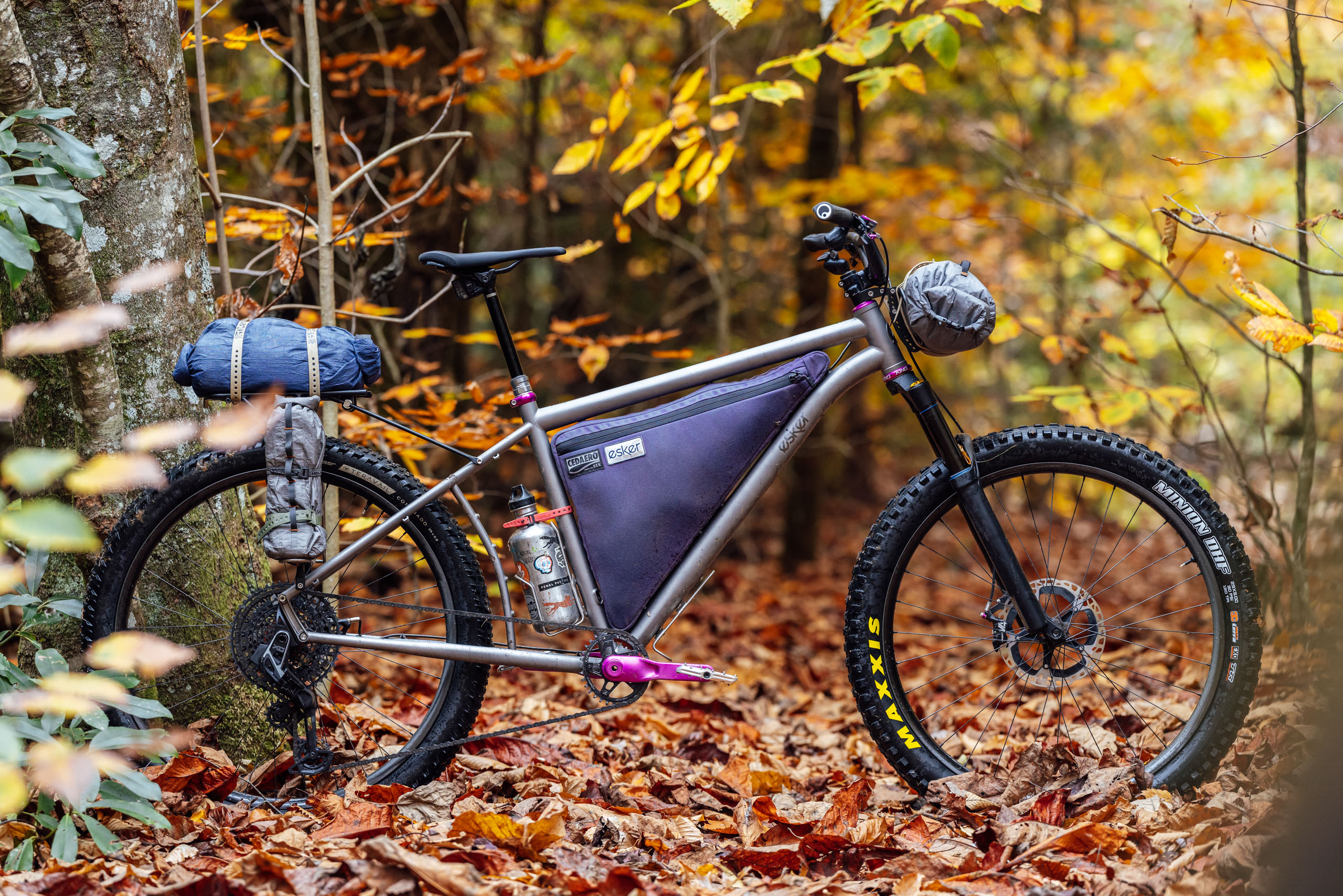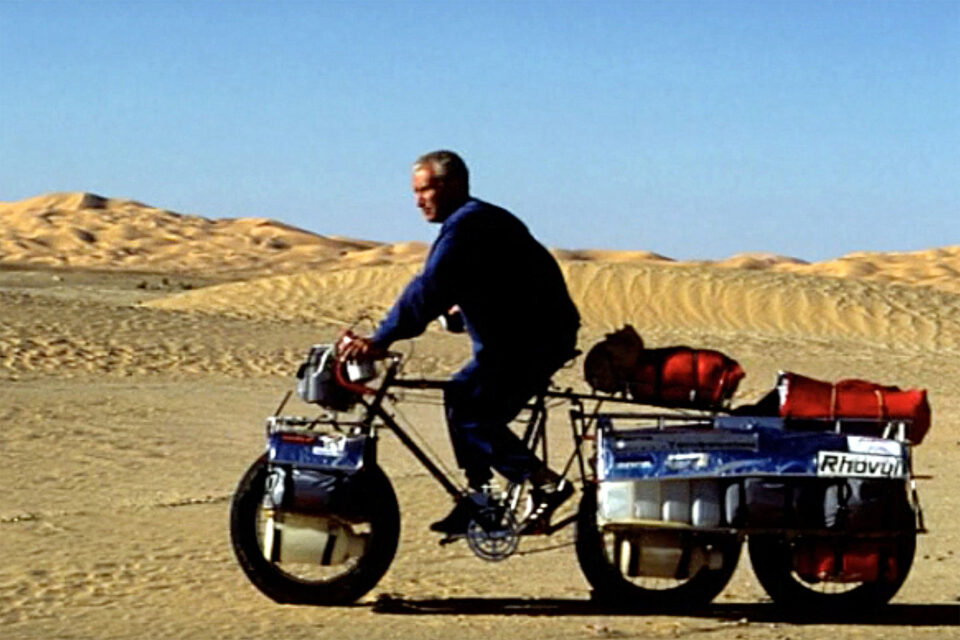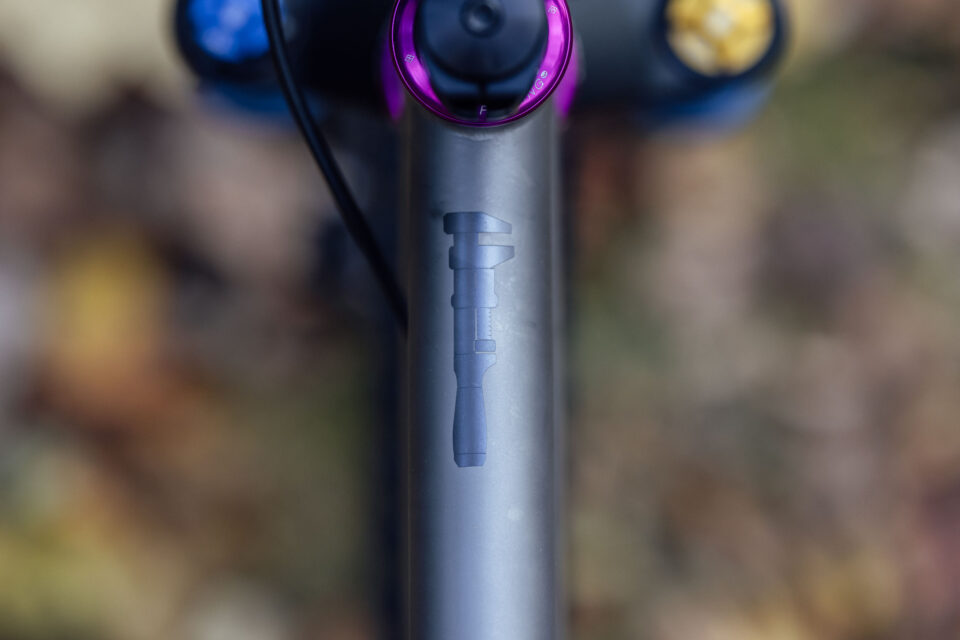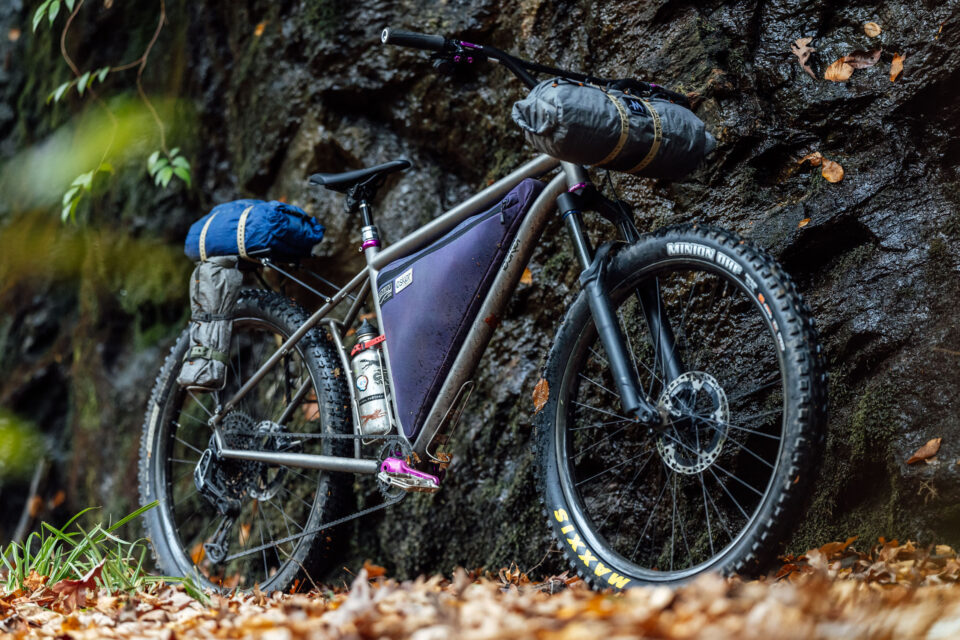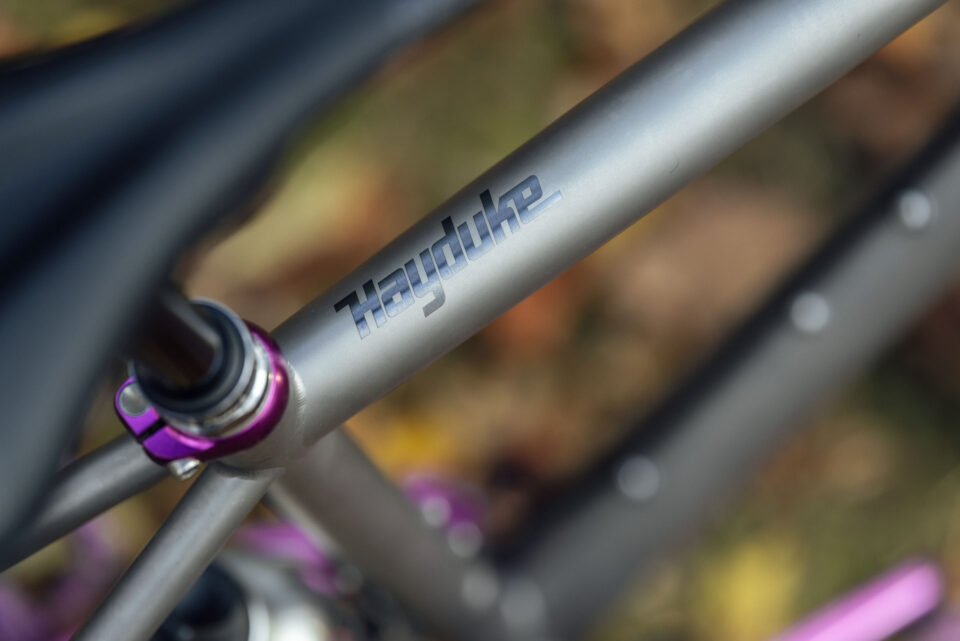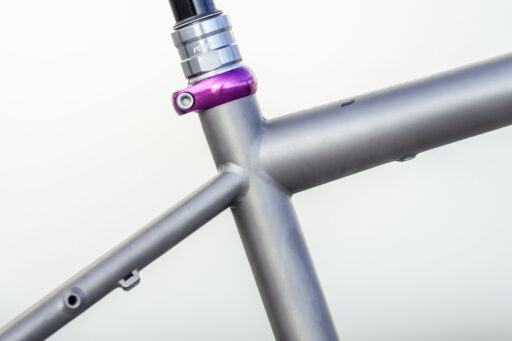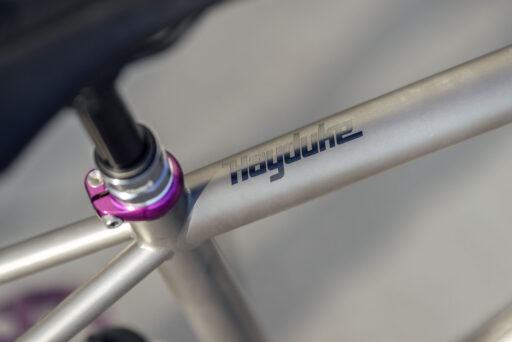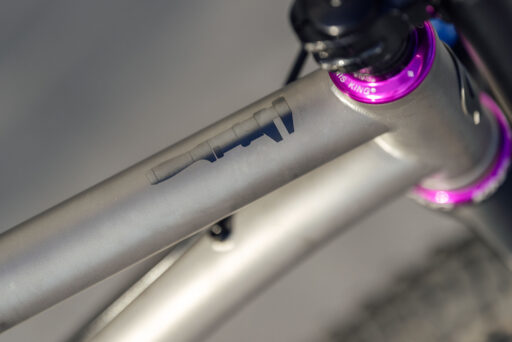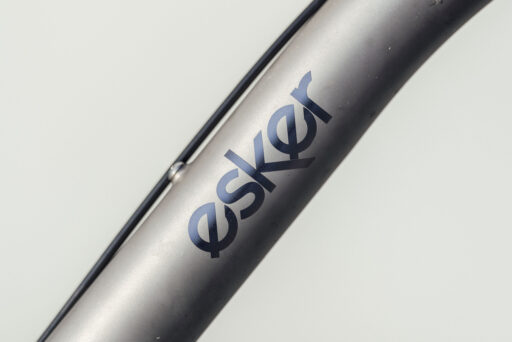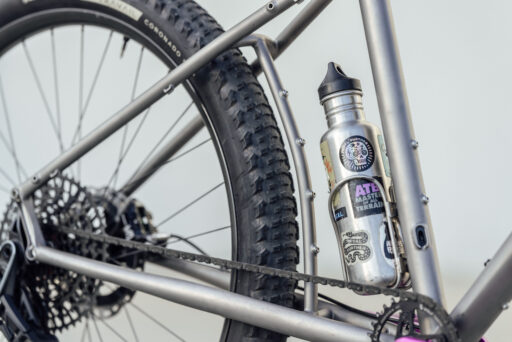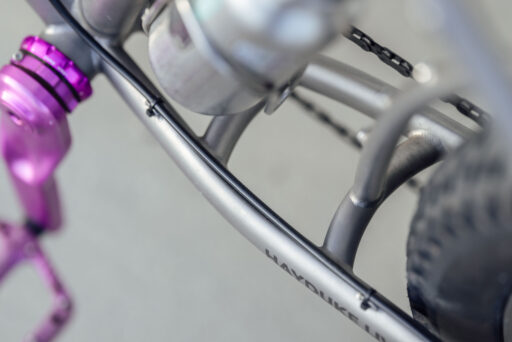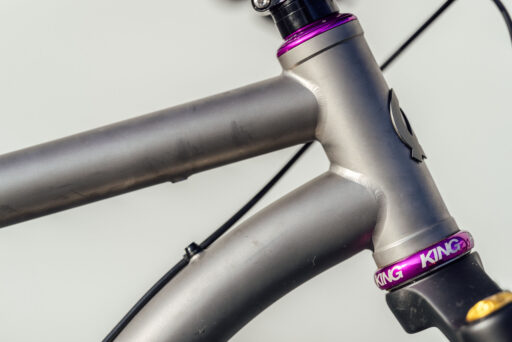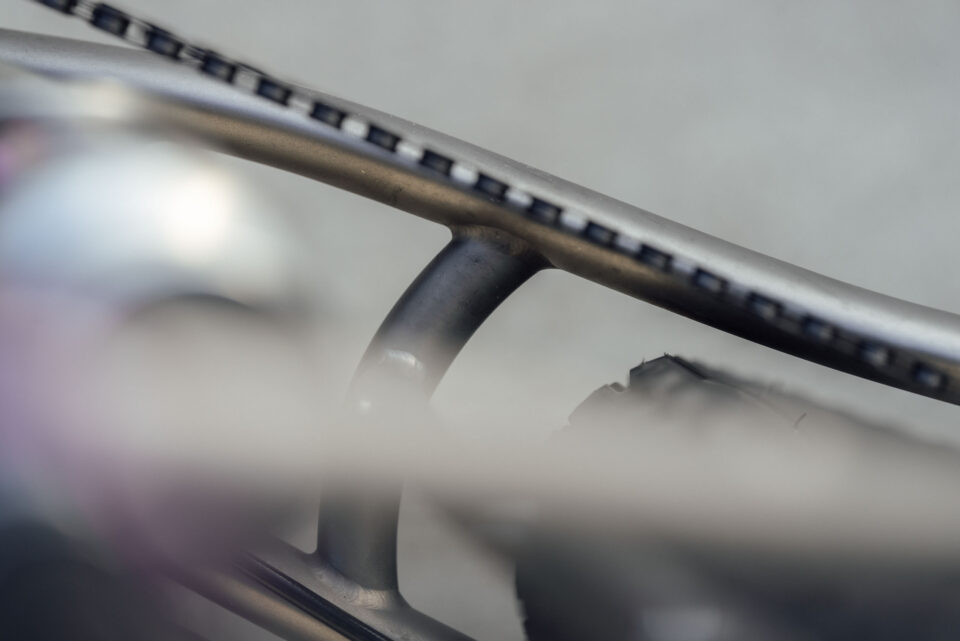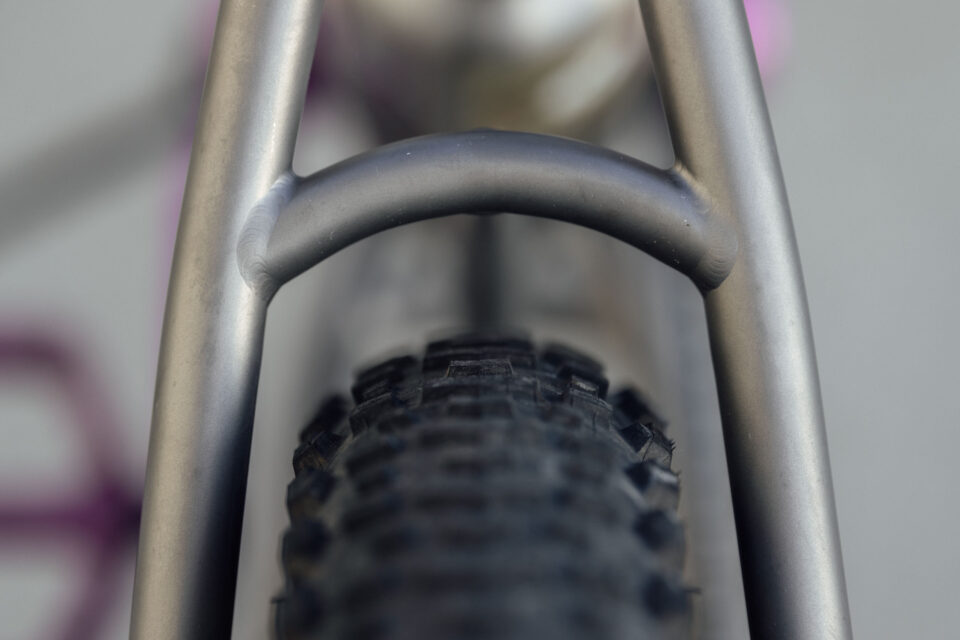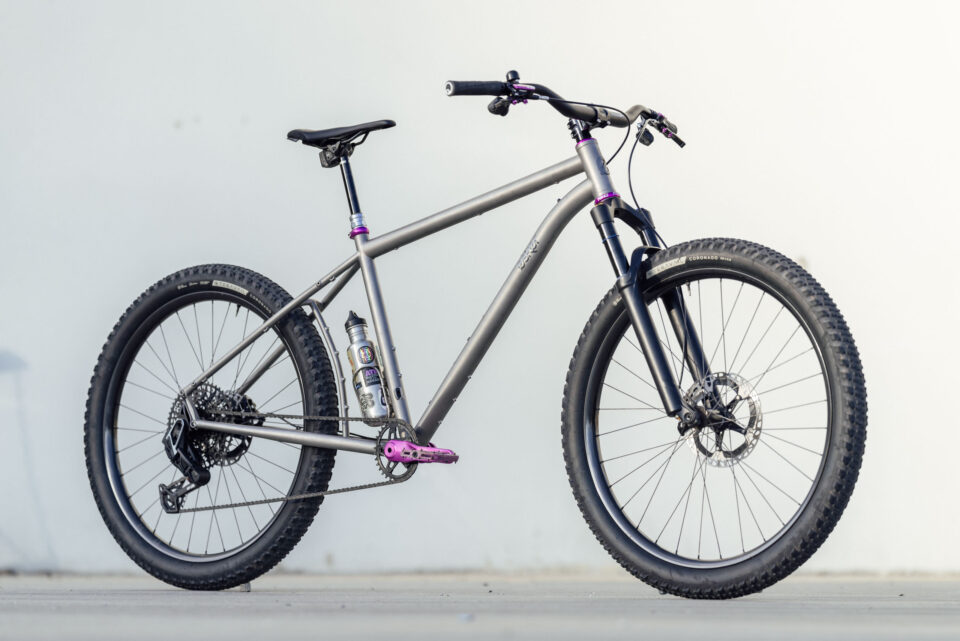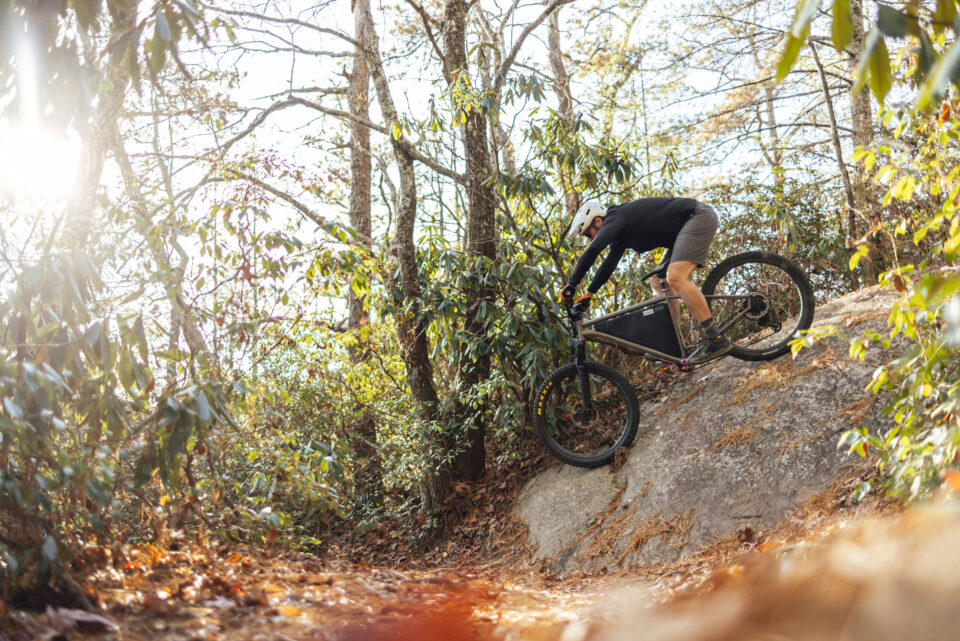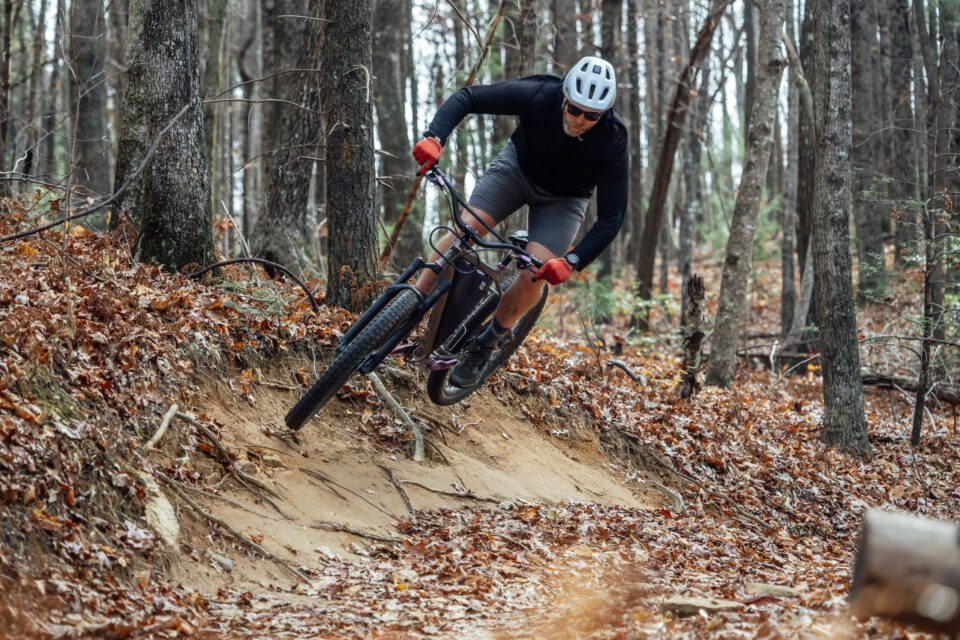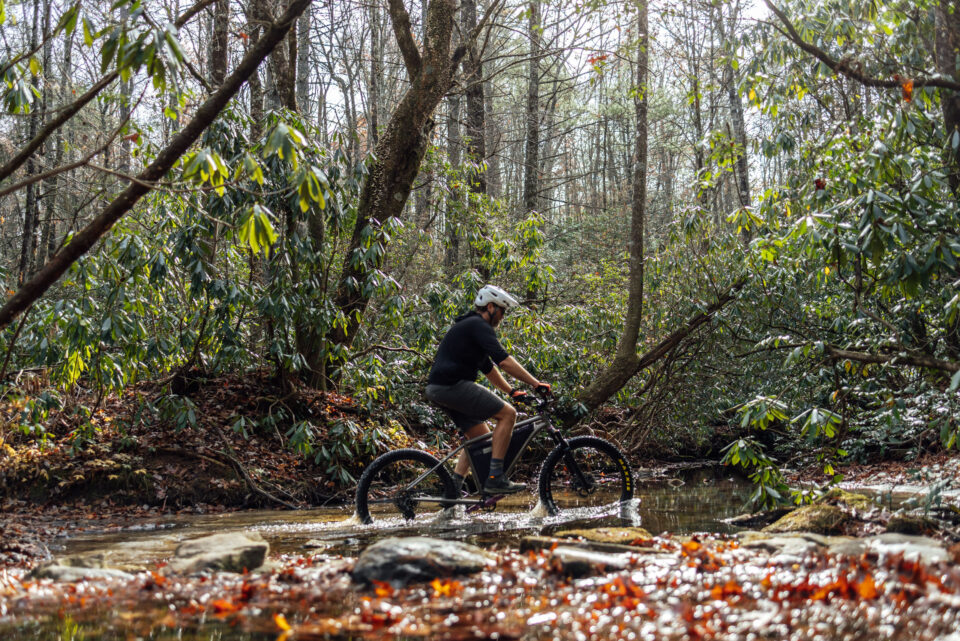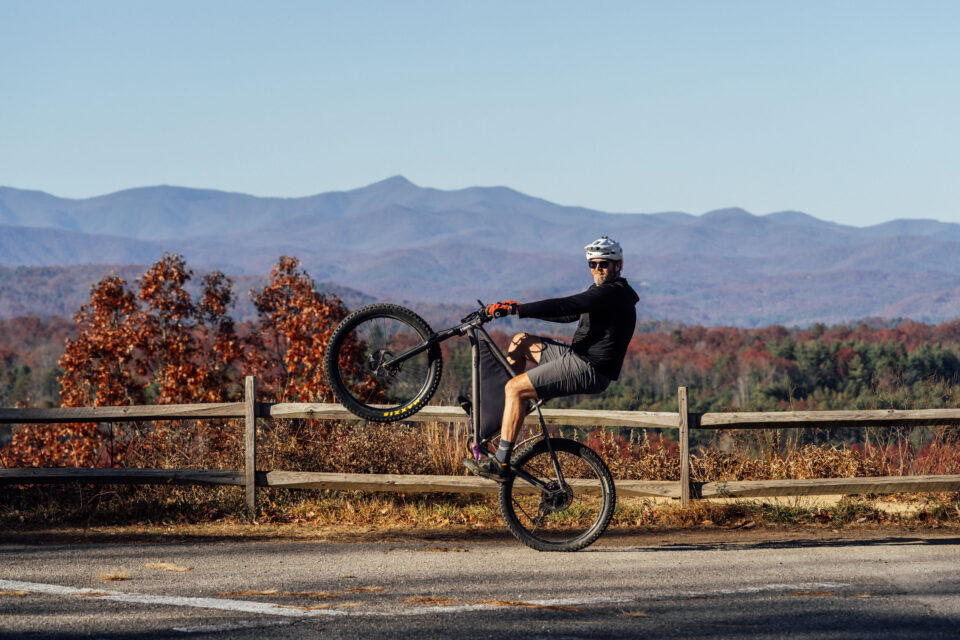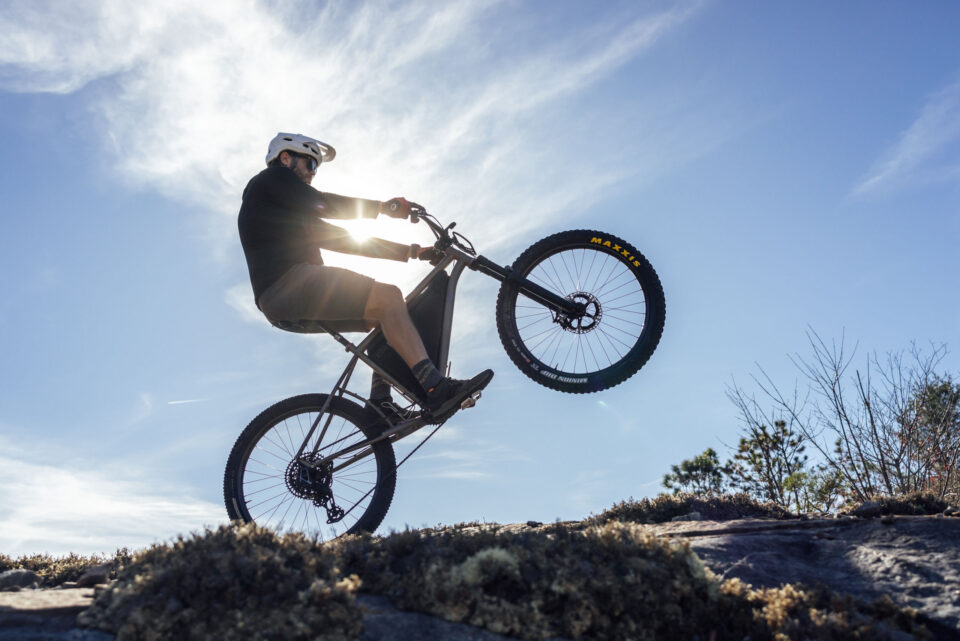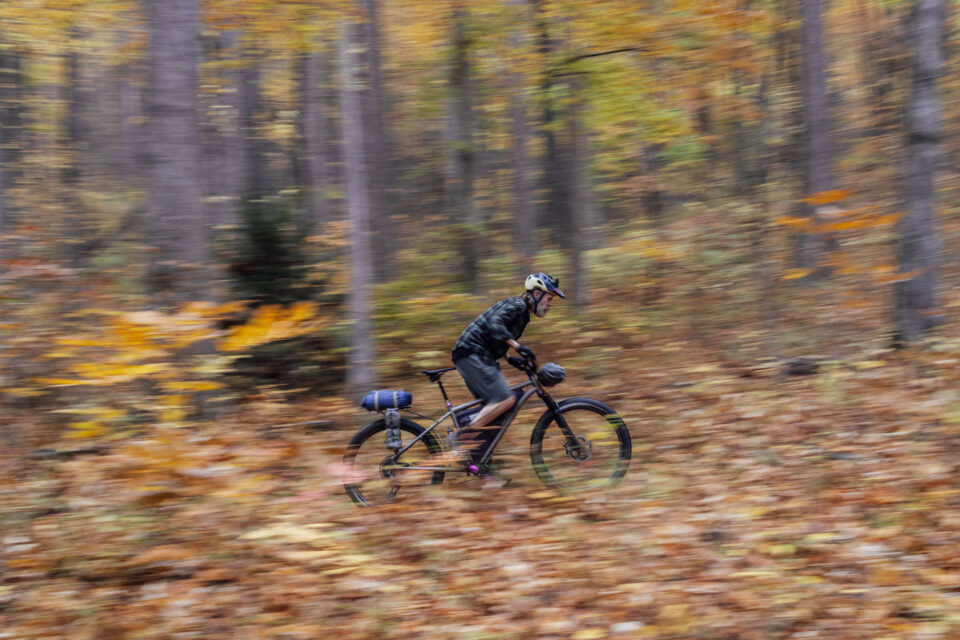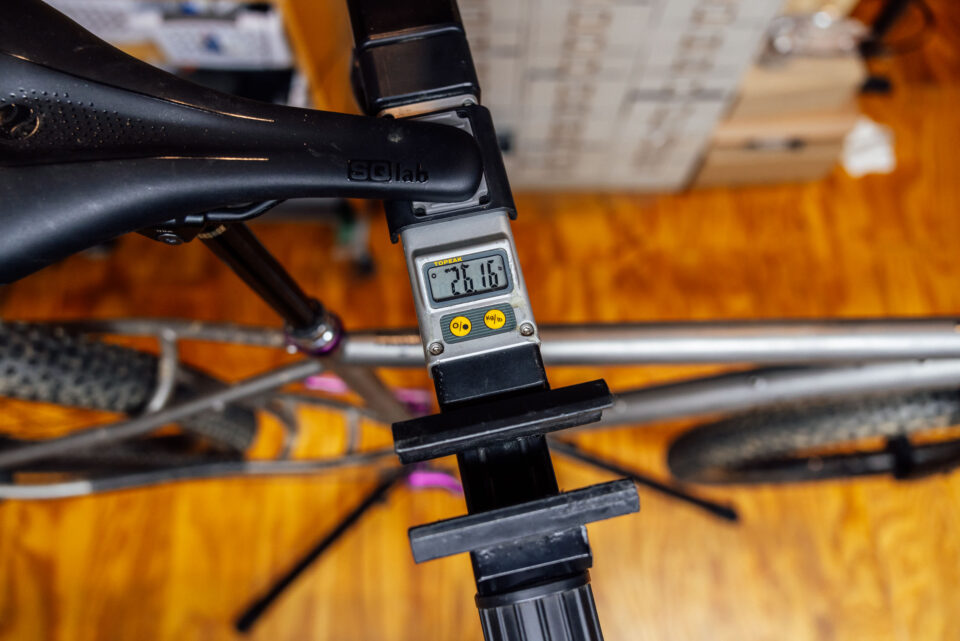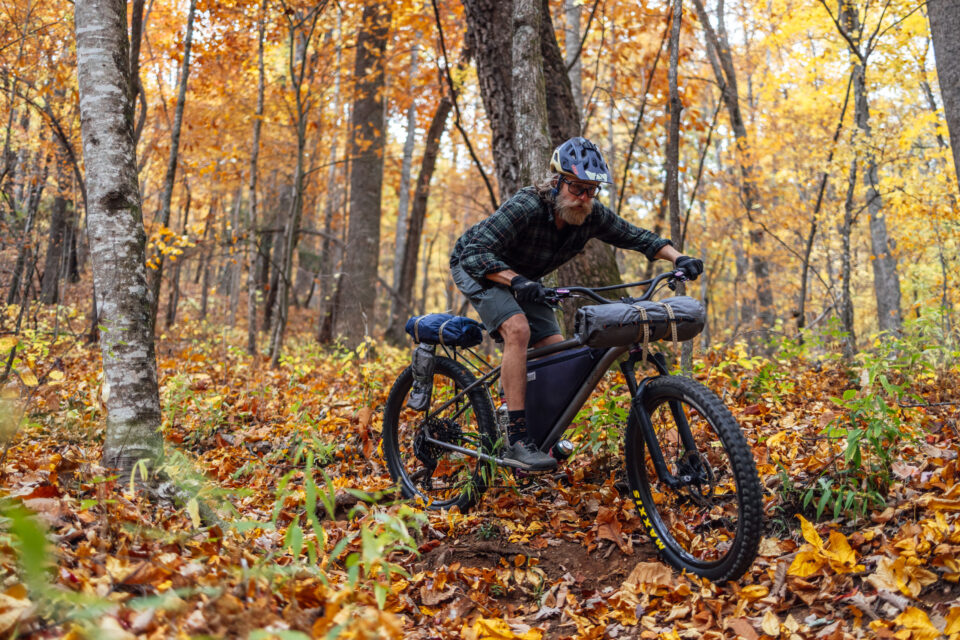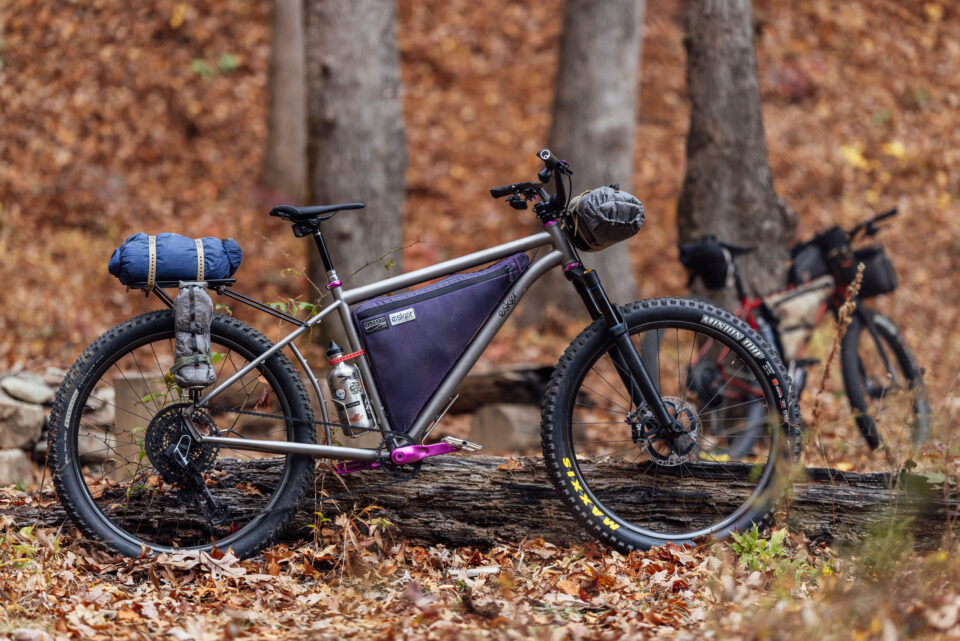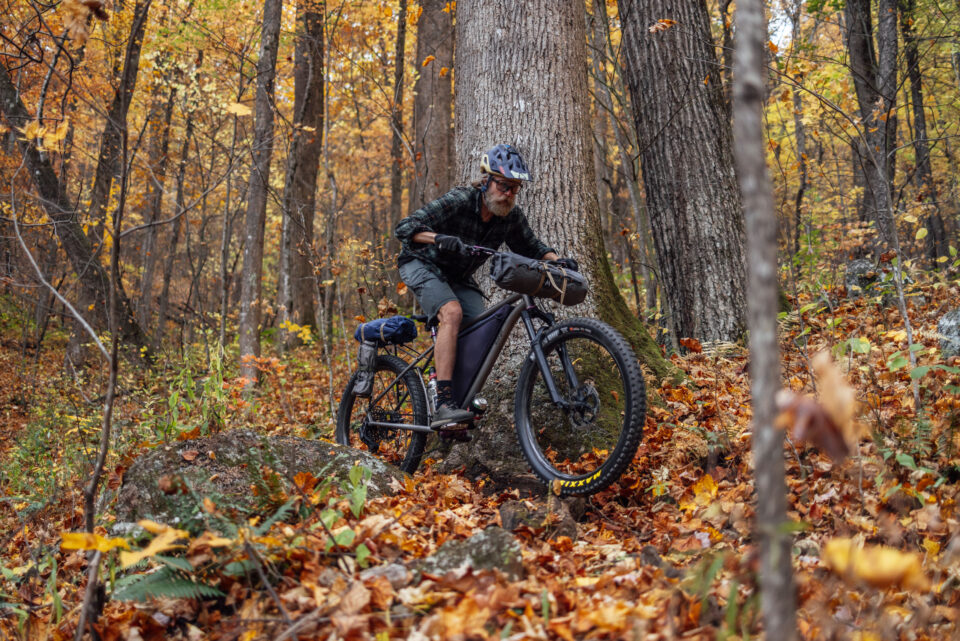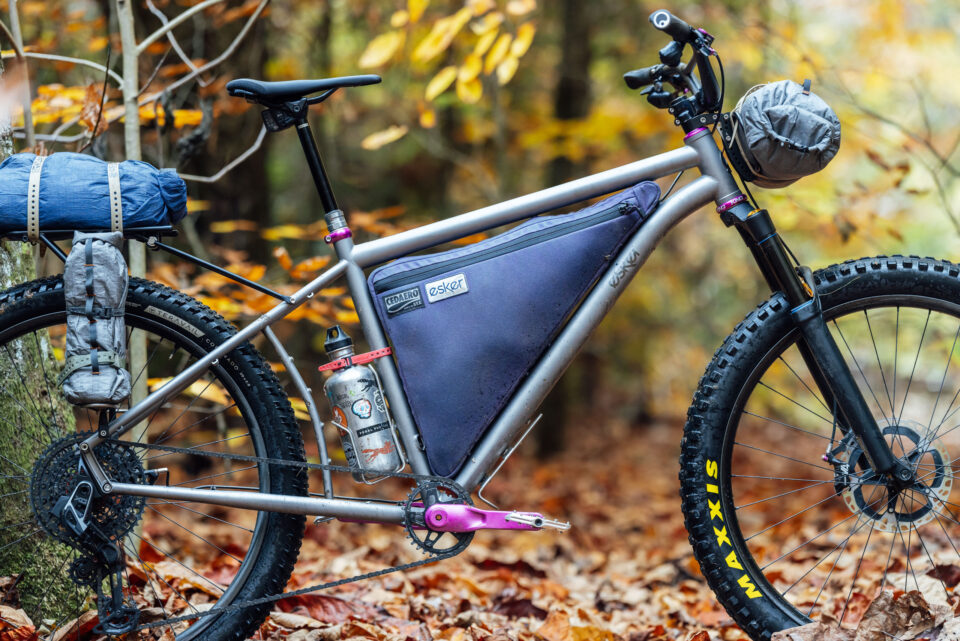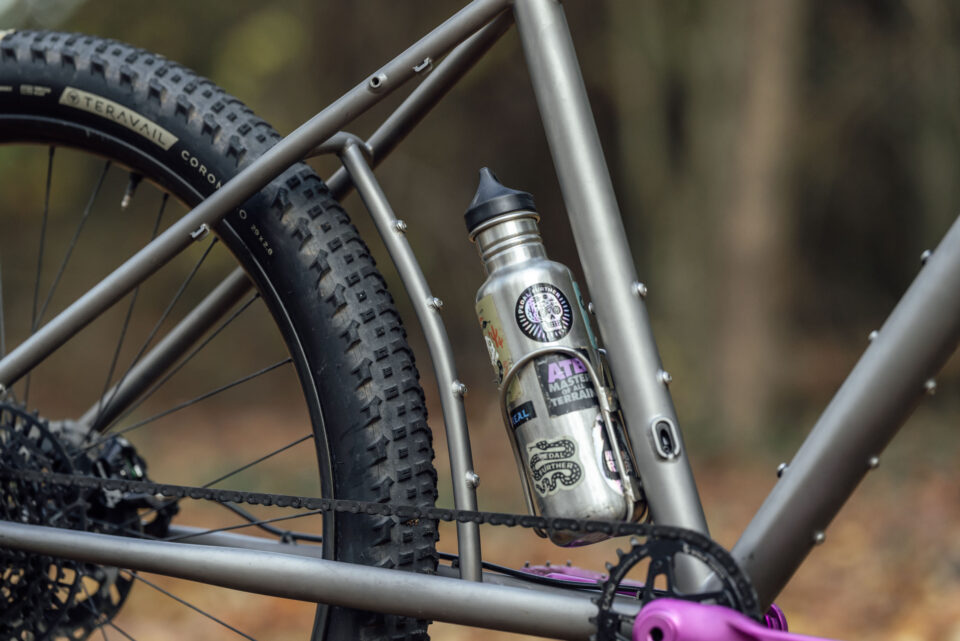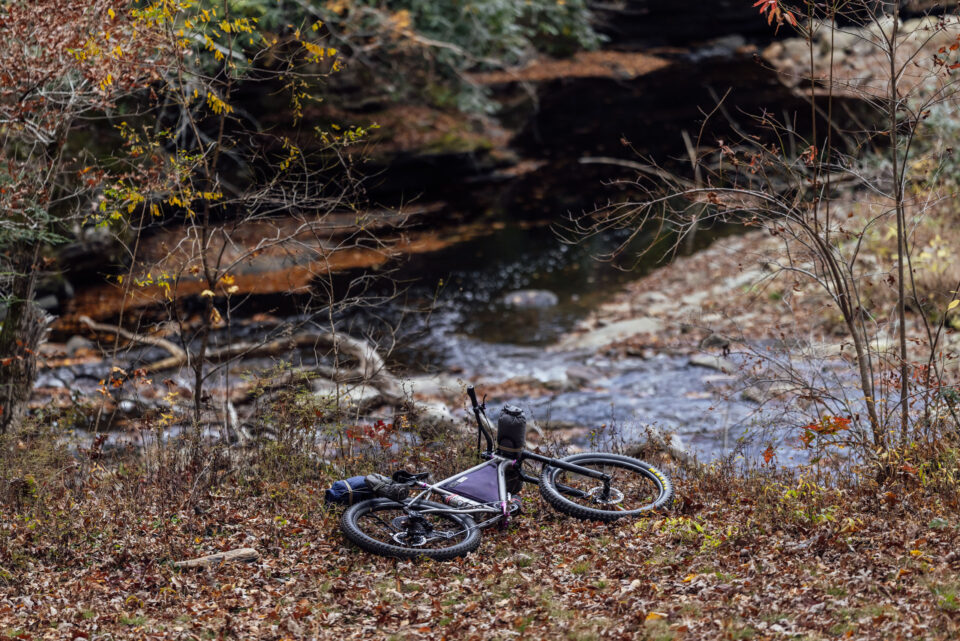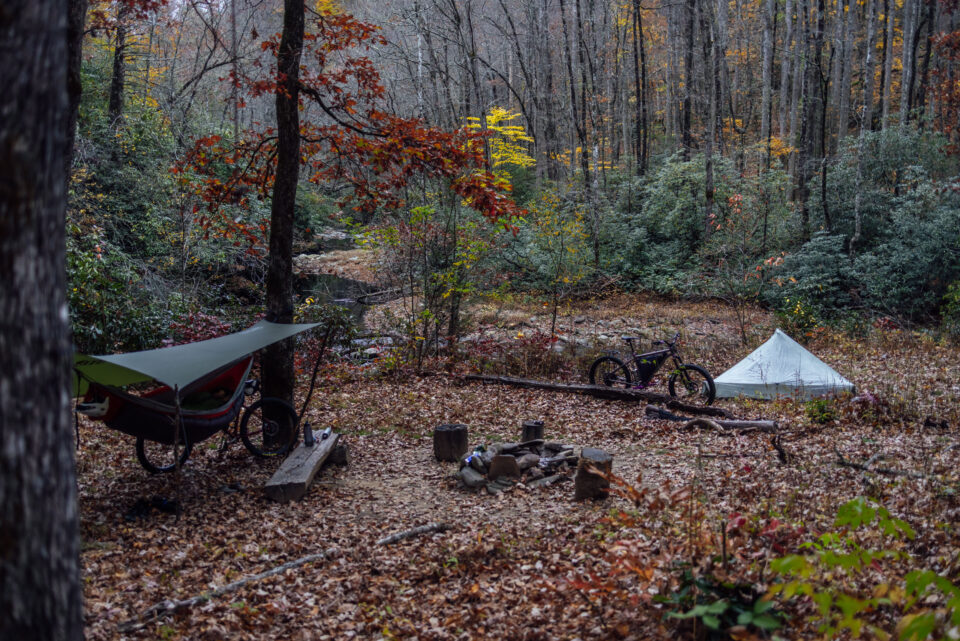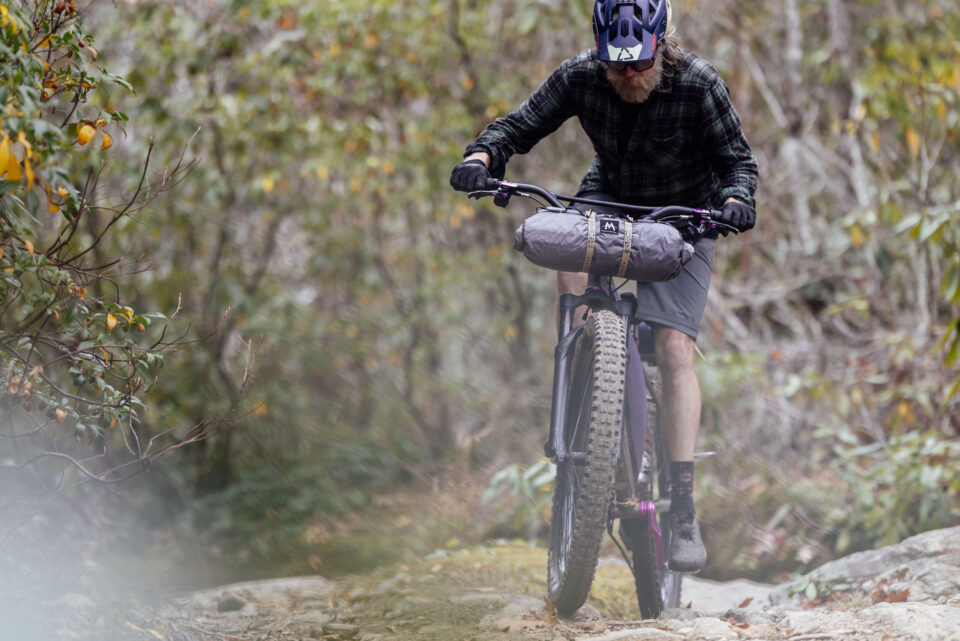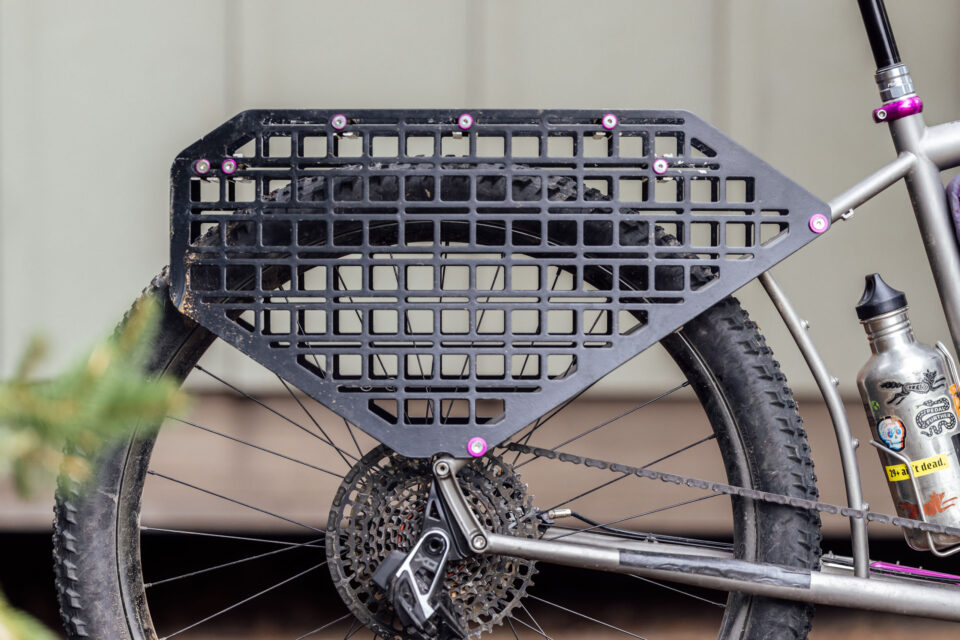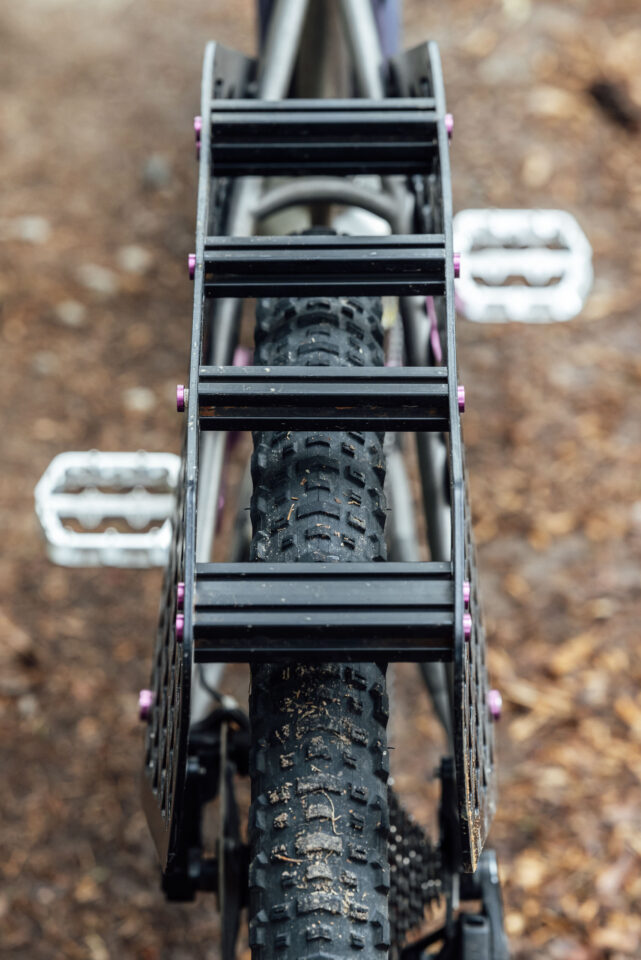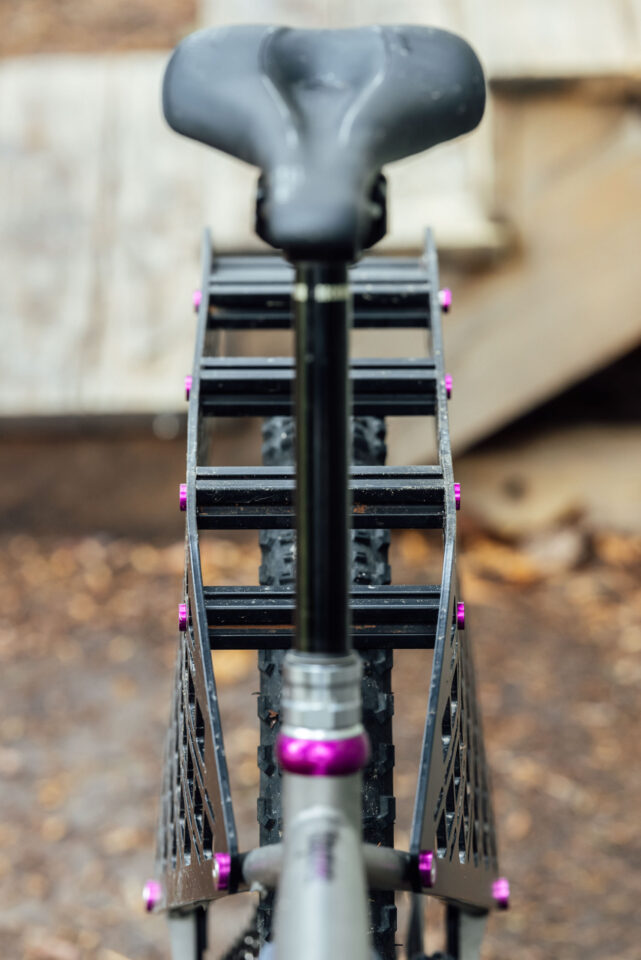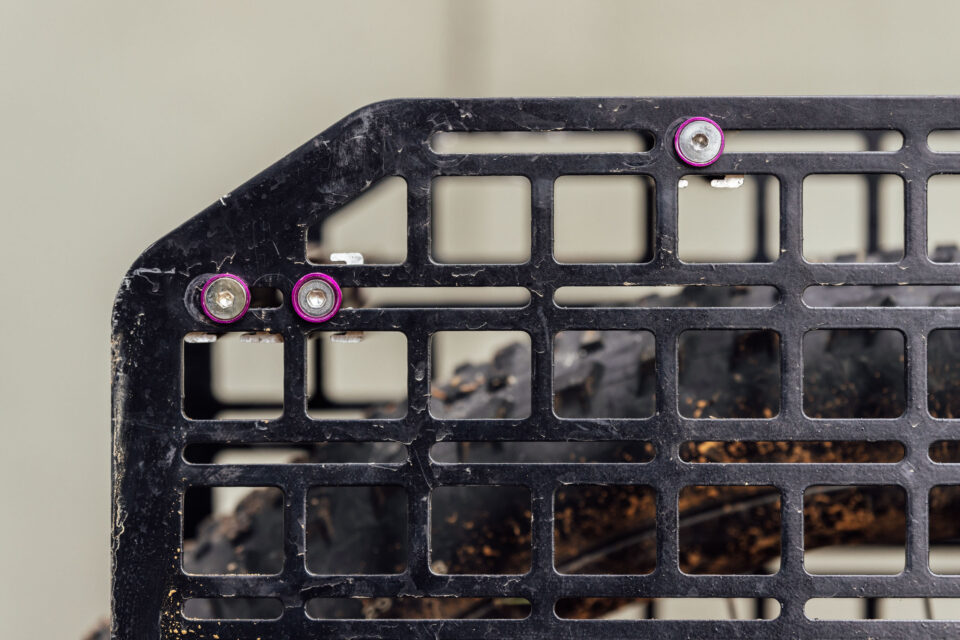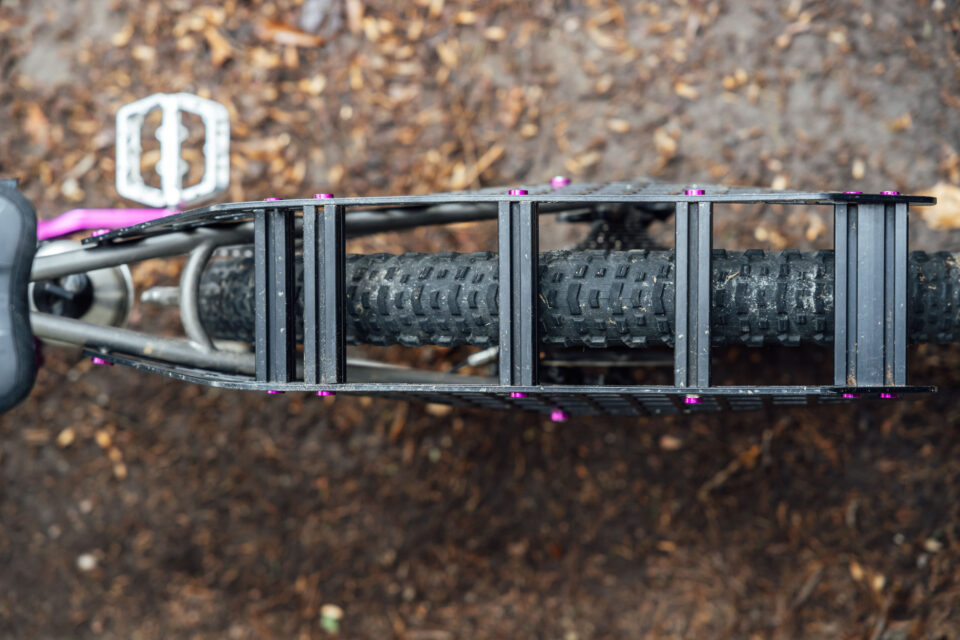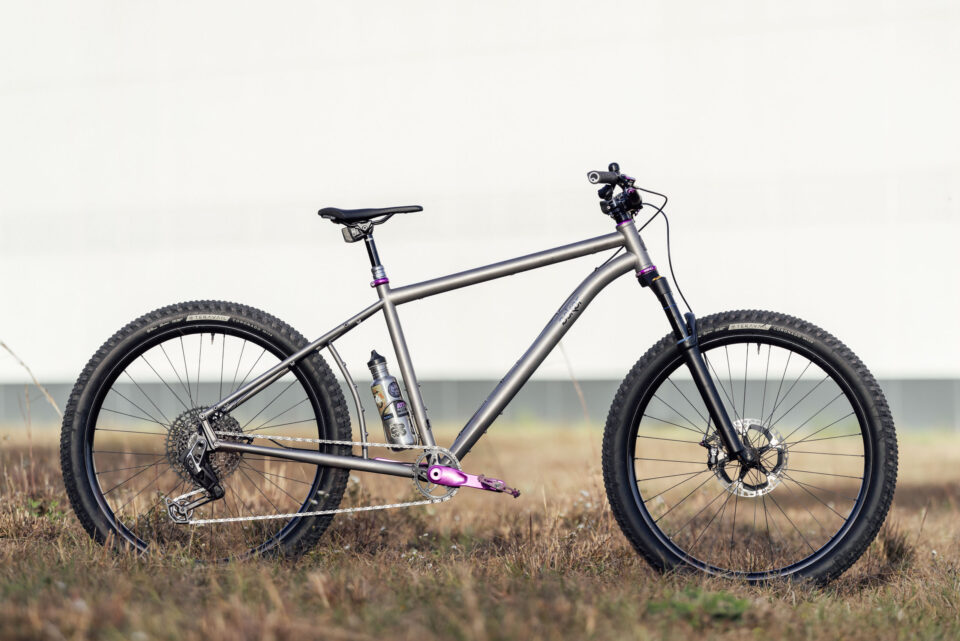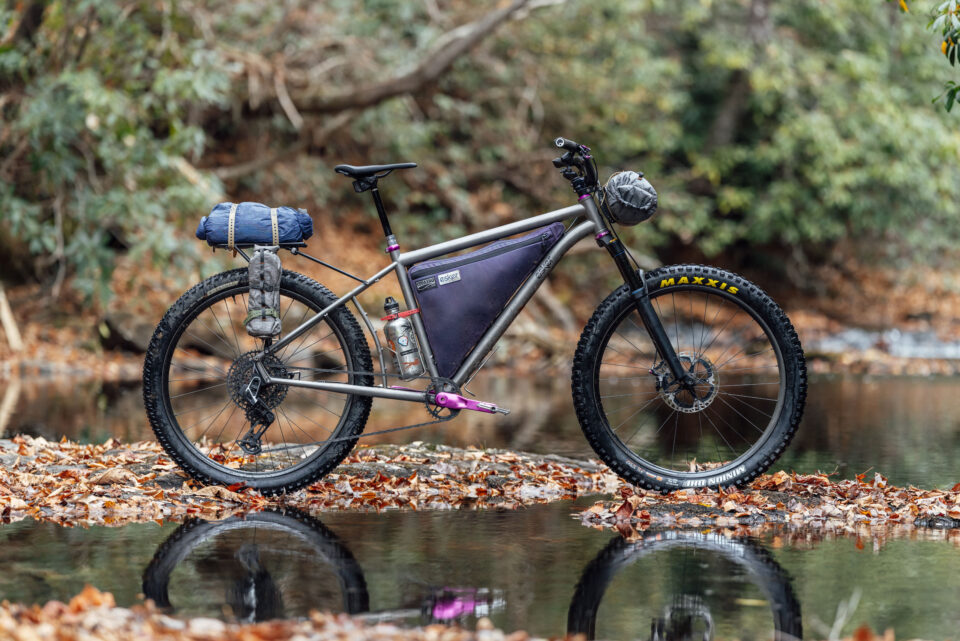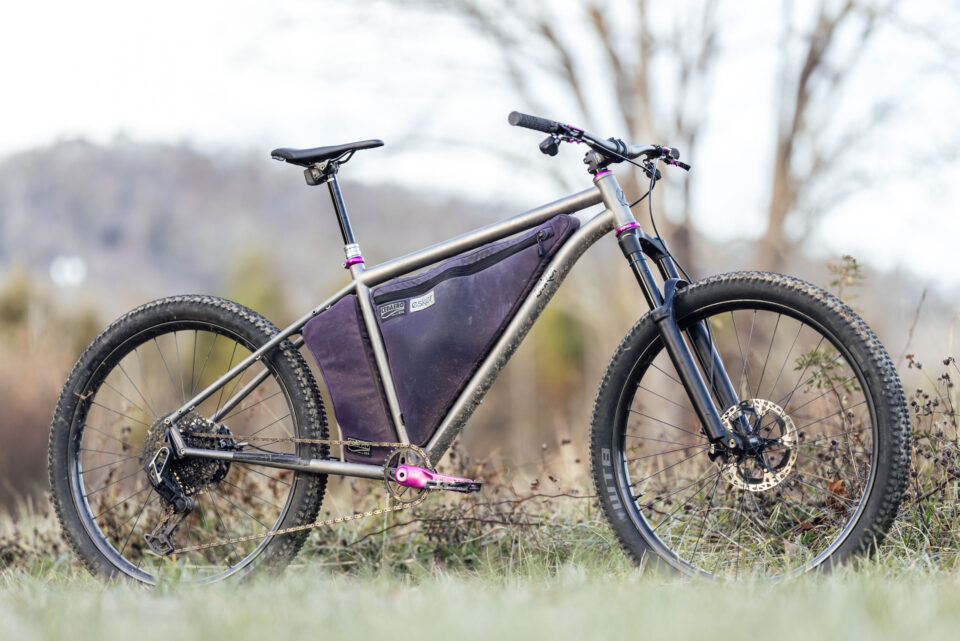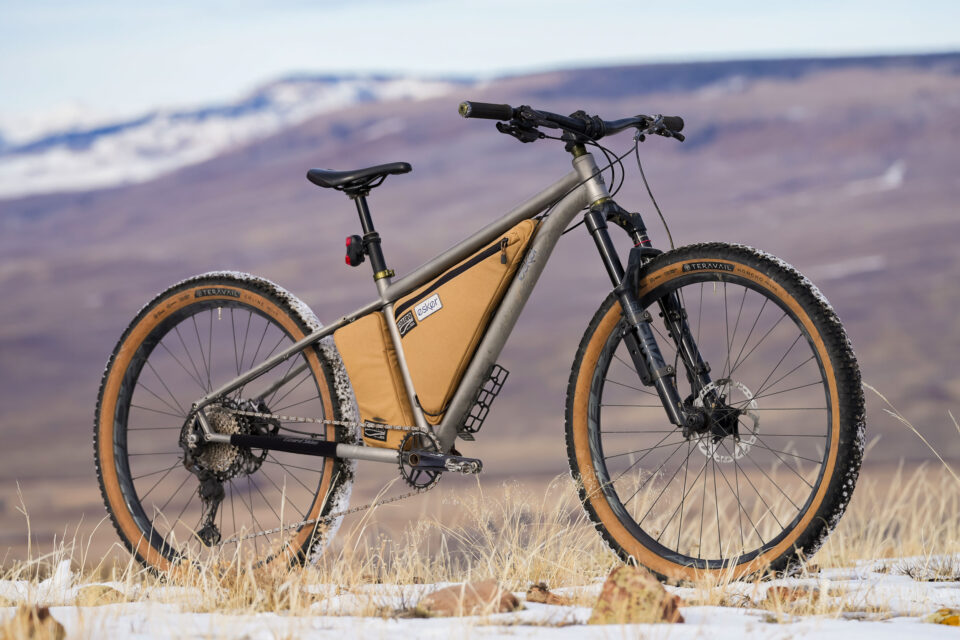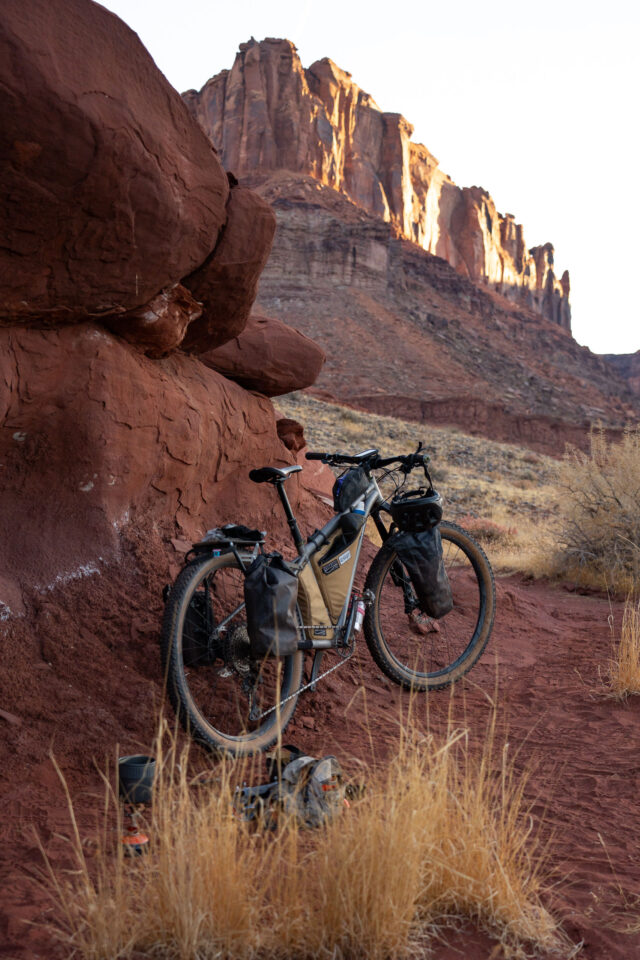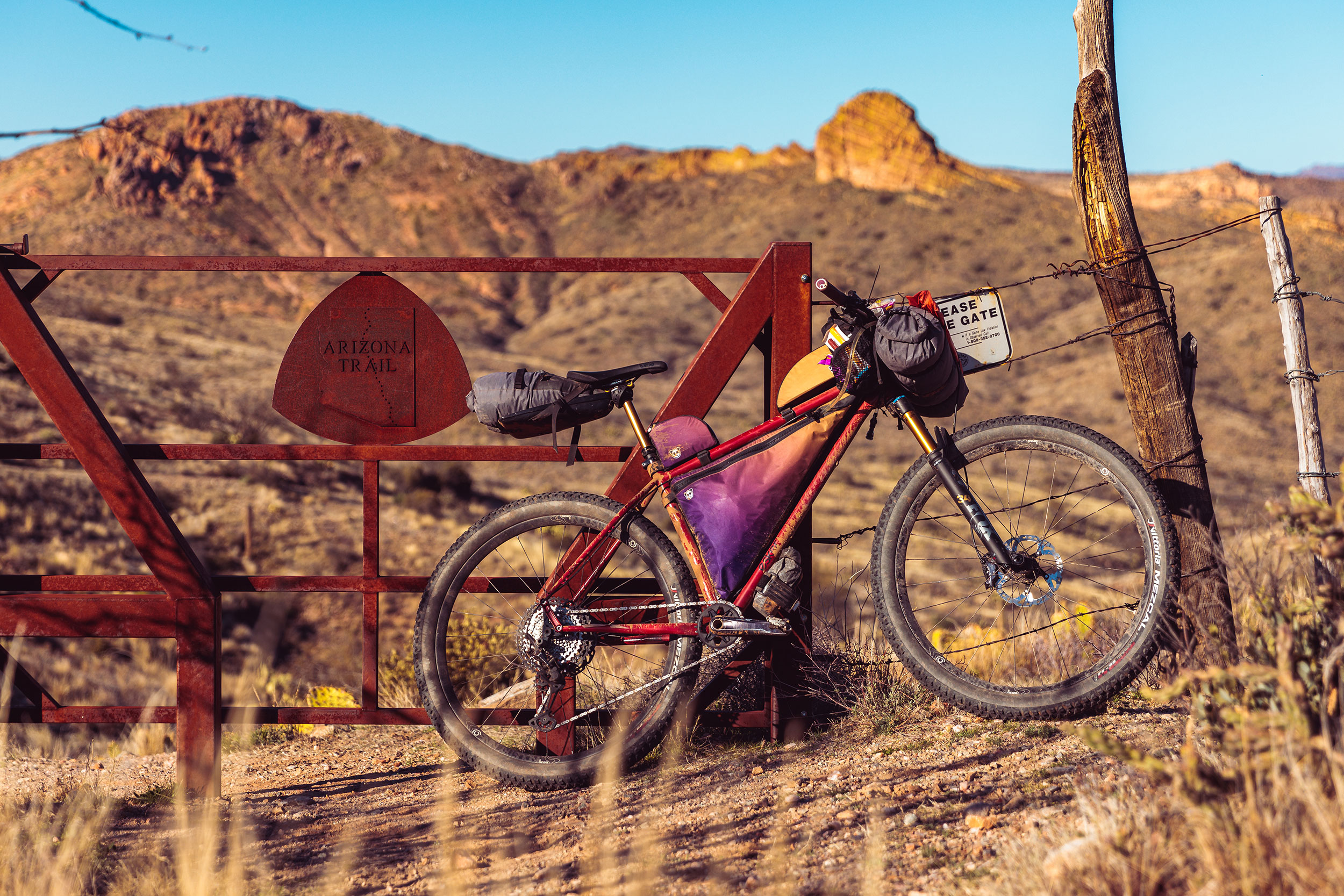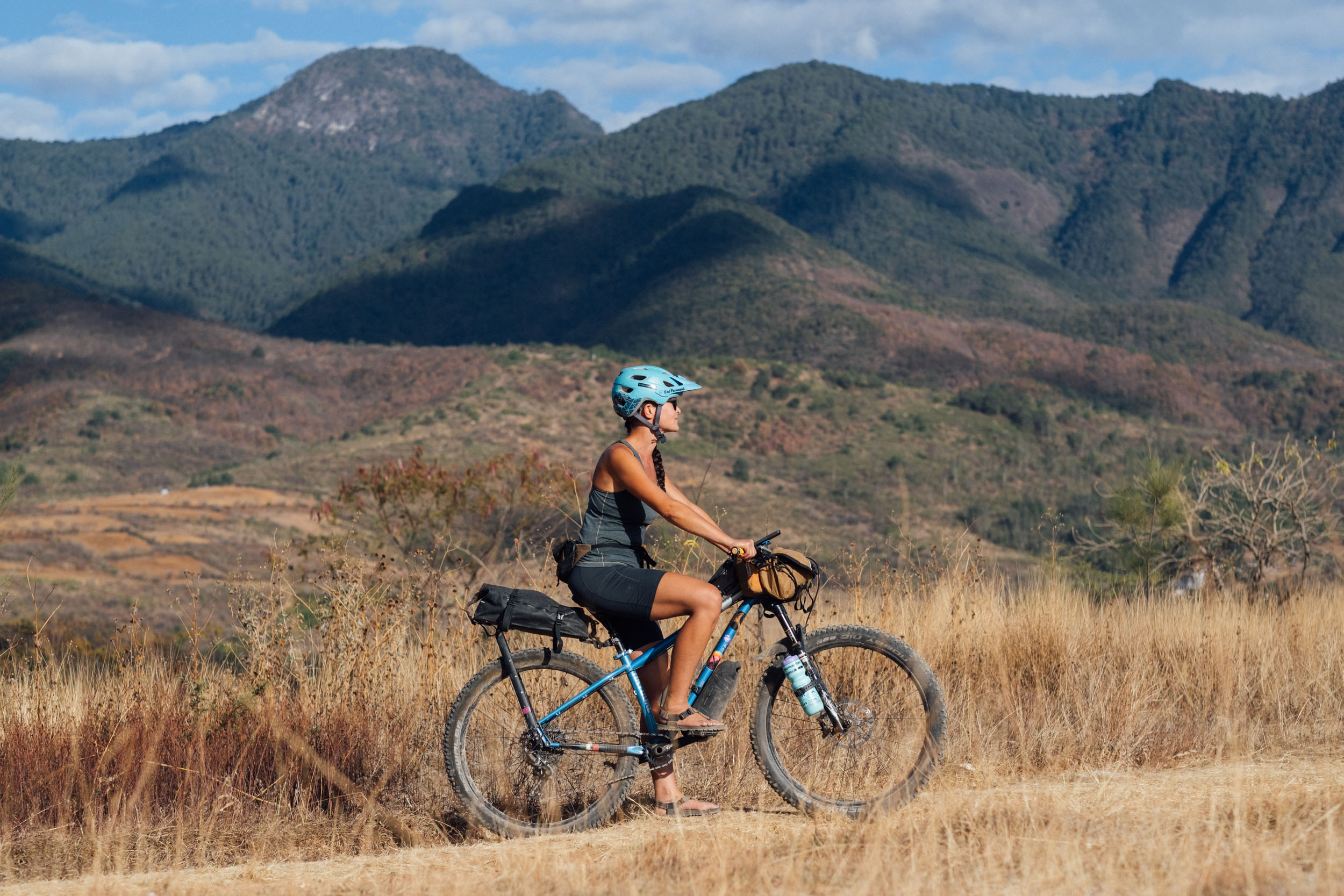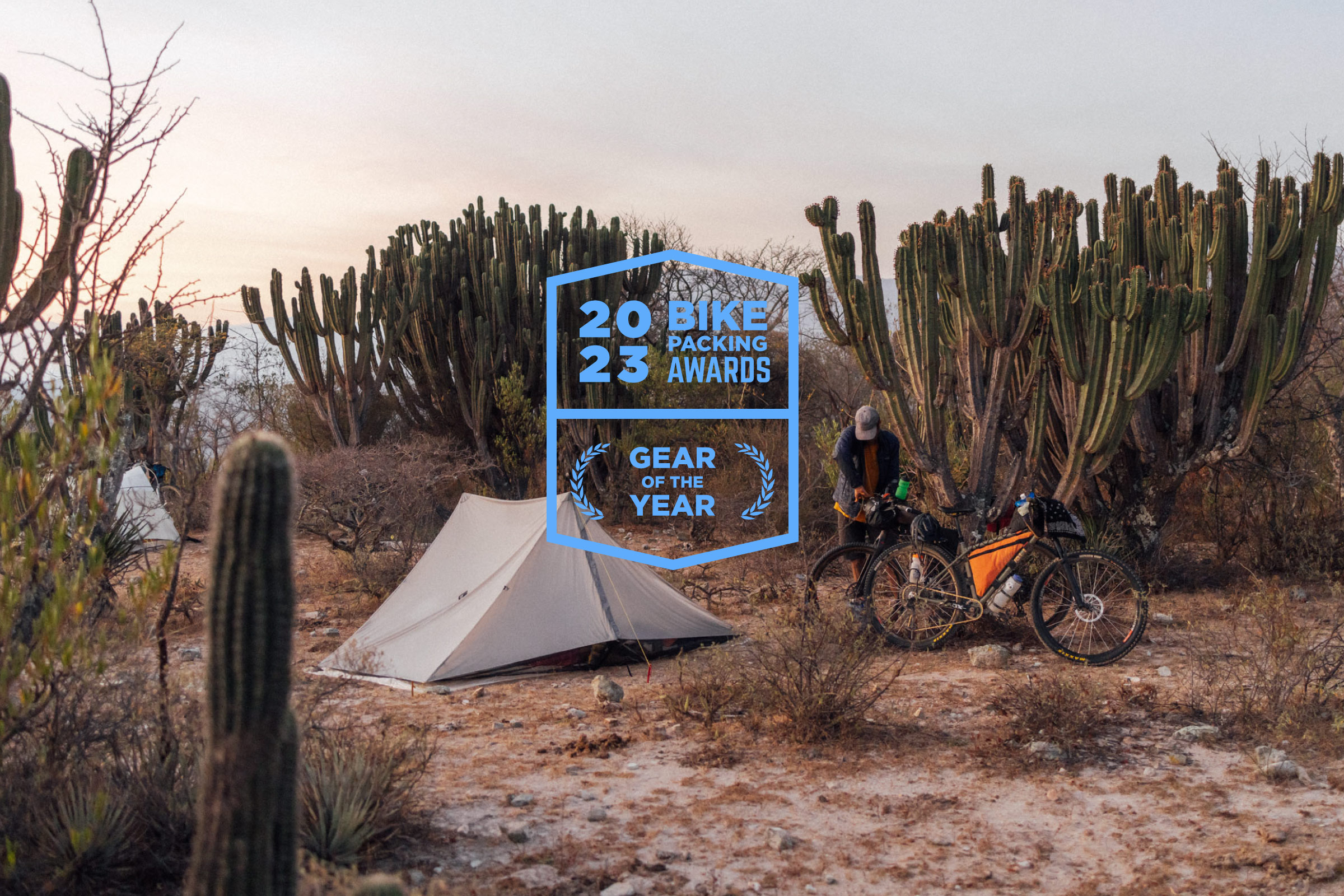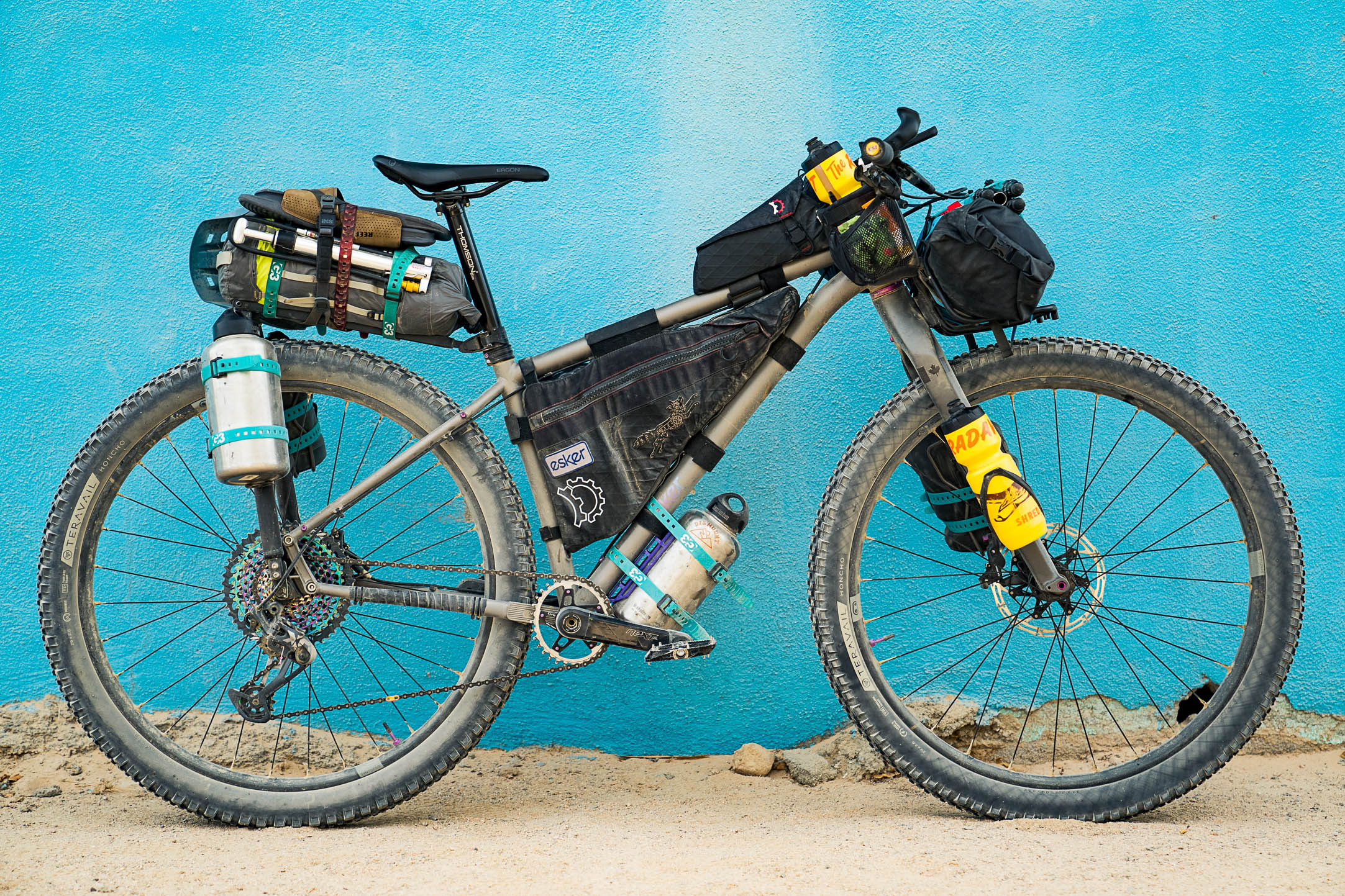Esker Hayduke LVS Review: A Future Classic
Share This
The Esker Hayduke LVS is the latest sibling in the now-classic bikepacking-oriented Hayduke lineage. However, with 600mm chainstays, a feature-laden titanium frame, and a unique overlanding rear rack, the LVS is completely different from its predecessor. We tested the Hayduke LVS for several months in all sorts of permutations. Find out how it stacks up as a gravel bike, a trail ripper, a wheelie machine, and a cargo-carrying rig in this detailed review…
Preface: TJ Kearns and I both spent a ton of time with the Esker Hayduke LVS for this review, as did Neil Beltchenko. Note that I’ll be freely inserting TJ’s perspective throughout this review in italics, and you can find Neil’s YouTube video review embedded toward the bottom of the post.
The Esker Hayduke LVS is unlike any bike we’ve reviewed on the site before. However, mid/longtail bicycles are nothing new, and they’re undoubtedly phenomena that have influenced bikepacking as a whole. Xtracycle introduced the first consumer product dubbed “longtail” in 1998. Their open-source Free Radical conversion kit transformed existing donor bicycles into extra-long-wheelbase cargo-carrying machines. The success of Xtracycle’s frankenbike system later influenced one-piece mid and longtail cargo bikes such as the Kona Ute and Surly Big Dummy—both released around 2008—and later the Salsa Blackborow.
But before all of that, there was a head-turning one-piece longtail bicycle born during a monumental 20,000-mile bike expedition from Alaska to Argentina, known as Riding the Spine, a trip that helped shape bikepacking and big-tire dirt touring in the Americas as we know them today. The ringleader of this charismatic group of riders, Goat (yep, that’s his name), designed Chupacabra in 2007 to carry more using Xtracycle racks and panniers and to go anywhere via a pair of novel and voluminous 3.8” Surly Endomorph tires. That bike was the stuff of legend and served as a massive inspiration for several of us old-timers here on the team. Goat’s longtail was a “reassuring proof of concept,” as Joe Cruz put it.
Still, a little more digging will show that this style of bicycle wasn’t totally revolutionary. A standout example is Jean Naud, a Frenchman who traveled some 3,200 kilometers across the Sahara Desert from Algiers to Timbuktu on a custom longtail fat bike in the late 1980s. His custom-built three-wheeled fat bike was a one-of-a-kind, designed to carry 72 liters of water with a pivoting rear end and prototype Michelin tires.
The long and short of it is that design-savvy cyclists have come to the conclusion that extra-long bicycles might be the best way to travel in remote and challenging terrain for decades. And while modern options might not be as groundbreaking as those early concepts, they share a similar sense of wonder and innovation, all for the sake of reaching far-off places via seldom-used dirt tracks.

Esker Hayduke LVS Rundown
The Esker Hayduke LVS is such a vehicle. It’s quite different from all the bikes mentioned above, but it’s equally as inspiring and obviously cut from a similar cloth. Like the Chupacabra and Naud’s moonrover-esque bike, the LVS was built specifically for hauling extra cargo while overlanding, although it’s equally suited for gear-schlepping duties on multi-sport trips, short glam-packing outings, or whatever type of adventure you can dream up that requires a little extra packing space.
The original Hayduke was inspired by the Baja Divide and is a longstanding favorite among the bikepacking community. With steel and titanium iterations of the normal-length Hayduke anchoring the range, the LVS is the next of kin and aptly takes its naming inspiration from Hayduke Lives, Edward Abbey’s follow-up to his renowned novel The Monkey Wrench Gang. It can also be open-ended. We made up a few of our own meanings for the LVS abbreviation: Lengthy Versatile Steed, Long Vacation Seeker, and Large Valiant Sojourner were a few we came up with when it was announced.
To summarize, the Esker Hayduke LVS has an efficiently constructed, cold-formed 3/2.5 titanium frame optimized for a 120mm suspension fork and clearance for 29 x 2.8″ tires. The LVS also features external cable routing, a threaded bottom bracket, the recently updated Portage Dropout equipped with a UDH (Universal Derailleur Hanger), and a 44mm headtube consistent with all Esker hardtails. Here are the specs from Esker:
- Frame Material: Seamless, butted and cold-shaped 3/2.5 titanium
- Thru Axle: Boost 148 / 180mm / M12x1.0
- Frame Includes: Seatpost collar, rear axle, sliding 148mm dropout, Wolftooth Components headset
- Headtube Diameter: 44mm ID, 50mm OD
- Rear Dropout Spacing: 148mm
- BB Type: Threaded 73mm English
- Headset Lower Stack Height: 13mm
- Wheel Size: 29 x 2.6-2.8″. Tire clearance on the Hayduke LVS is heavily reliant on the chainline of the drivetrain.
- Chainline: 49-52mm chainlines have a max clearance of 2.6″ and 55mm chainlines have a max clearance of 2.8″. Some drivetrain brands and models may also have variances.
- Seatpost: 34.9 clamp, 31.6 post, internally routed
- Max Chainring: 34T round / 32T oval / Boost Chainline
- Weight: 4.55lbs bare frame, 4.95lbs includes dropouts, axle, seat collar, and cable guides for a Medium frame
- Brake Mount: Post Mount direct, 180mm rotor native
But, It’s a Midtail
At 600mm, the Esker Hayduke LVS has the shortest chainstay length of all the bikes mentioned above. The Surly Big Fat Dummy’s is 875mm, the Blackborow’s is 650, and the Ute’s is 625. Esker calls the Hayduke a midtail bicycle. However, there’s no regulatory definition of what distinguishes a midtail from a longtail, and we won’t get in the weeds with this terminology. The Esker Hayduke LVS has longer-than-usual chainstays, period, and that’s unquestionably what makes it special. Not only do these elongated chainstays create additional room for racks and storage, enhancing the bike’s utility, but the extended rear end was specifically designed to provide a smooth ride quality and more stability. At the same time, the fact that they’re not too long is part of what sets this bike apart. When I asked Tim Krueger, Esker’s founder and designer, what gave him the idea for this bike, he responded with a statement that backed that sentiment: “The Salsa Blackborow rides amazing; I want[ed] one made for normal MTB wheels and drivetrains.”
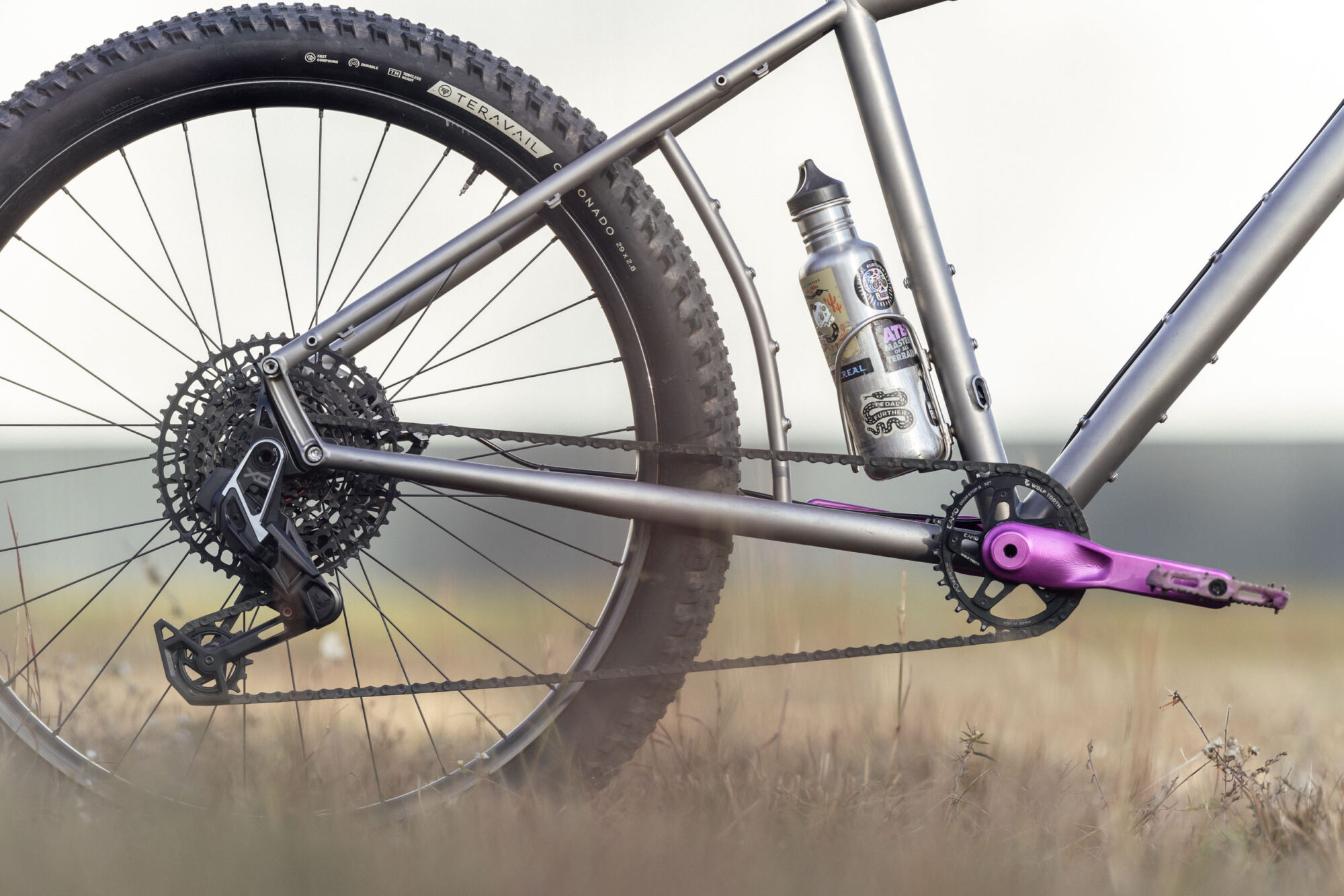
TJ: Longtail bikes such as the Surly Big Fat Dummy tend to be for just hauling a lot of stuff. Sure, you can take that bike off-road, but its geometry, weight, and length make it hard to handle when riding singletrack. It’s also incredibly flexy when loaded down, and it takes a lot of work to balance it at slower speeds in technical terrain. On the other hand, the LVS (26.6 pounds/12.07 kilograms) is less than half the weight of my BFD (58 pounds/26.31 kilograms), and the chainstay is 275mm shorter, allowing the bike to be more nimble out on the trail. To sum it up, the LVS rides like a mountain bike once you spend some time on it, and the BFD is more of a utility party barge.
Spoiler alert: Although my findings on the handling of the Hayduke LVS weren’t too far afield from TJ’s, I didn’t have the exact same experience. Generally, I was pleasantly surprised at how light, quick, and relatively fast-handling it was, but there was one caveat: it took a little more work for me to wrangle the XL LVS than it did TJ. For example, I found that correcting it could be a little cumbersome when tossed off line while descending technical trails. It wasn’t clumsy in that regard, and it had quick steering, which helps balance out the long rear end. It was bewilderingly nimble, even, and could actually be bunny-hopped. But like any vessel, the longer it is, the more it wants to hold its line.
Sizing and Fit
Part of the reason we had slightly different experiences is that TJ and I tested the same size XL LVS, changing just the saddle and bars between us. TJ is a big dude. He’s 6’5” tall (1.96 meters) and weighs about 250 pounds (113.4 kilograms). I measure 6’0” tall (1.83 meters) and around 170 pounds (77.1 kilograms) on the scale. It was a perfect fit for him (with a high-rise handlebar) and a little too large for me. I had no idea I would be getting a bike that was too big for me, but that was the reality I faced with this review.
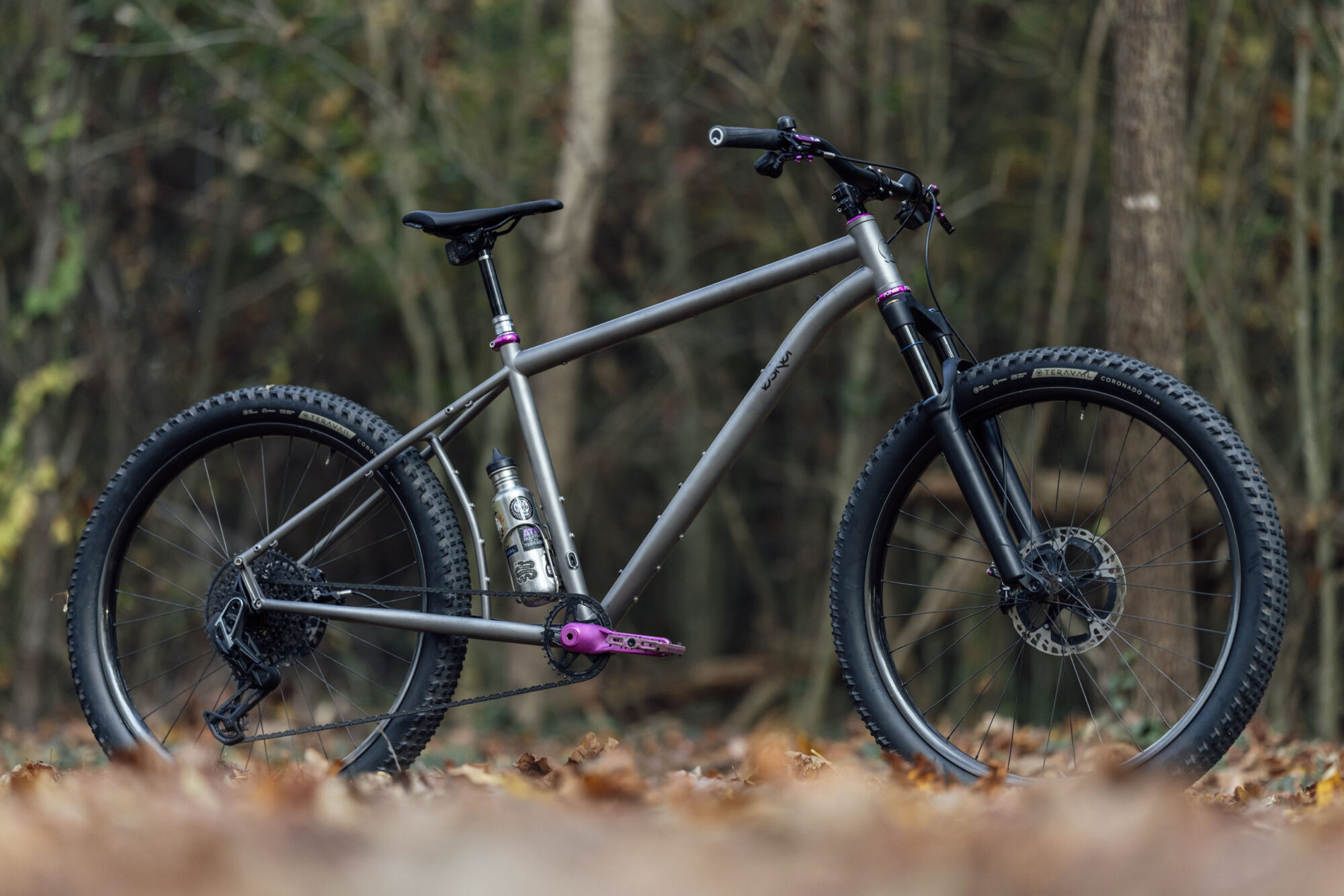
Part of the confusion came from getting the wrong info before the LVS was released. I originally understood that the LVS retained identical front triangle geometry to the Hayduke, the only difference being the chainstay length. That’s not completely true, though. Looking at the S3 (L) Hayduke with a 470mm reach and a 634 effective top tube (ETT), it just seemed too small for me. The S4 (XL) has a 658mm effective top tube length and a 490mm reach, which is more like most of the bikes I’m riding these days. With that tidbit of info, I let Esker know I wanted to test the XL LVS. However, once I got it—and the geometry was released—I realized that the LVS has a substantial sizing jump between the S3 (L), which has a 654mm ETT, and the S4 (XL), boasting a 675mm ETT. Had I known, I may have opted for the S3 size, but I made it work. In the end, it’s the size I would commit to if I were to buy one—I’ll dig into my reasoning a little later.
Considering it’s a pretty stout XL frame and has all those trusses, supports, and mounts, I was shocked at how light it was. Frankly, that’s the other factor that really sets the Esker Hayduke LVS apart from all the aforementioned extra-long bikes, or any commercially available long/midtail that we know of, for that matter. The only other titanium mid/long-tail bike we can think of is John and Mira’s custom dogpacking rig.
Trail Mode
Our test bike was Tim’s personal bike that he lent us for review. It had a really nice parts kit, which kept it pretty light, and despite having a relatively heavy Eagle Transmission and Ohlins RFX36 fork, it weighed in at just 30.88 pounds (14.01 kilograms) without pedals. That’s less than most of my hardtails and quite impressive considering this bike’s stature, an extra-long chain, and 2.8/3.0” tires. I had zero complaints about the parts kit listed below.
- Frame Esker Hayduke LVS, XL
- Fork Ohlins RFX36, 130mm
- Wheels We Are One Rims (40mm IW), I9 Hydra Hubs
- Front Tire Teravail Coronado, 29 x 2.8, Durable
- Rear Tire Teravail Coronado, 29 x 2.8, Durable
- Crankset Ignite Catalyst
- Chainring Wolf Tooth CAMO, 32T
- Derailleur SRAM X0 Eagle Transmission
- Shifter SRAM X0 Eagle Transmission
- Cassette SRAM X0 Eagle T-Type, 10-52T
- Bottom Bracket Chris King
- Handlebar Stooge Moto (swapped to Whisky Milhouse)
- Grips Ergon GA3
- Headset Chris King
- Brakes Hope Tech4 E4
- Saddle SQlab ErgoWave 614
- Seatpost Rockshox Reverb AXS, 170mm
TJ: From the Hope brakes to the We Are One carbon wheels to the Chris King headset and BB, Tim’s bike is among the nicest builds I’ve ridden. I’d only change a few things based on personal preference. I’d change out the crankset for Cane Creek EE Wings for the bling factor. A Wolftooth Resolve Dropper plus some Oddity Ti OddMoné Bars would be nice if we’re talking dream builds here. In a perfect world, I’d also get a Ti truss fork because I’ve always wanted to ride one, and I think it would look so cool on this bike.
On the Trail
I spent a fair amount of time riding my local singletrack on the LVS in this configuration. As mentioned, I was pretty impressed with how agile it was on technical trails, although it takes a little more work to correct when tossed off line. I generally liked trail riding with it, though. To me, it was kind of akin to underbiking, where familiar terrain feels nuanced and fresh on a different type of bike—like pedaling a rigid bike or singlespeed on trails you usually ride on a suspension-equipped MTB. Then again, the LVS was almost like overbiking.

Descending
The Hayduke LVS undoubtedly provided a different perspective on downhills. And despite having a relatively steep head tube angle, the ultra-long wheelbase made it incredibly confident. It was like having a rear ballast that keeps you firmly planted; even on steep descents, there’s little chance you’re going over the bars on this bike. Having the beefy 130mm Ohlins fork reinforced its confidence. Still, the steering felt quick and active, which balances things. This overconfidence got me in trouble a few times, again, going back to not being able to correct or right it once off line. TJ didn’t have that issue…
TJ: This bike rips on the downhills. It’s obviously not as playful as my 120mm Transition Spur, but I can still jump and even throw some whips and table-tops on it. I was very surprised with how nimble it is on the descents and how stable it is at speed. Descending on gravel is a wide-open affair, and the bike’s pilot is the only limiting factor. The sole area where I’d say it falls short is very steep terrain with drops, but again, that’s not the bike’s intended purpose or where most people are likely to ride it.
Climbing
The LVS requires a mindset shift when climbing technical singletrack. The long rear end keeps the bike planted and the front anchored to the trail on steep climbs, but I had to remain seated to keep the weight on the rear tire or I often ended up spinning out. Once I became habituated to this technique, I could tractor up anything while seated as long as my legs had the strength. The bike’s planted stability accentuated this, and it really felt like it could go anywhere, slowly. Conversely, technical, ledgy singletrack climbs weren’t where the LVS shined. I found it hard to get the front end up and over lips and ledges, so it was often better to just get off and push. Thankfully, it’s not as heavy as it looks.
TJ: The LVS is very efficient while climbing up gravel, dirt roads, and most singletrack until the trail gets rough enough that the wheelbase keeps you from being able to hop up and over ledges, roots, or downed trees. I think an old-school bash guard and a 28-tooth chainring would be great for this bike if you want to try motoring up stuff.
Keeping traction on steep terrain is also very dependent on your rear tire choice. Low-profile/fast-rolling tires will break traction even easier on the LVS due to the more forward weight bias. I found this even more apparent when riding the bike with 2.6 WTB Rangers. It was very easy to spin the tire on loose or slick steep climbs. That being said, I think those fast-rolling tires suit the bike’s intent better than running something like a MAXXIS DHR or a more aggressive tire. The advantages everywhere else are just too much to sacrifice for technical climbing traction.
Ride Quality
If you’re like me and expected the Hayduke LVS’s protracted titanium frame to act like a long carriage spring, resulting in the most compliant bike ever, you’d be wrong. It wasn’t as supple as I expected it to be. It generally feels like a well-engineered hardtail, meaning it’s stiff enough that you feel ledges, drops, and larger bumps, but ride quality wasn’t ignored in the design. Comparing it to other hardtails I’ve tried, I’d put it in a similar class as my Cotic Solarismax or other very well-engineered steel and Ti hardtail frames. To put it succinctly, I’d still give it a five-star rating in the ride quality category. The LVS is clearly designed to carry a heavier-than-usual load, but it also seems to be properly engineered to buffer knocks and bumps when riding unloaded.
It’s about as supple as I’d want a hardtail to be, especially considering that it still feels sturdy enough and capable of carrying hefty payloads without feeling like a wet noodle. And once packed up, which I’ll talk more about later, you can certainly get a sense of lateral flex, but it’s not overtly flexy. Without a load, it feels rock solid.
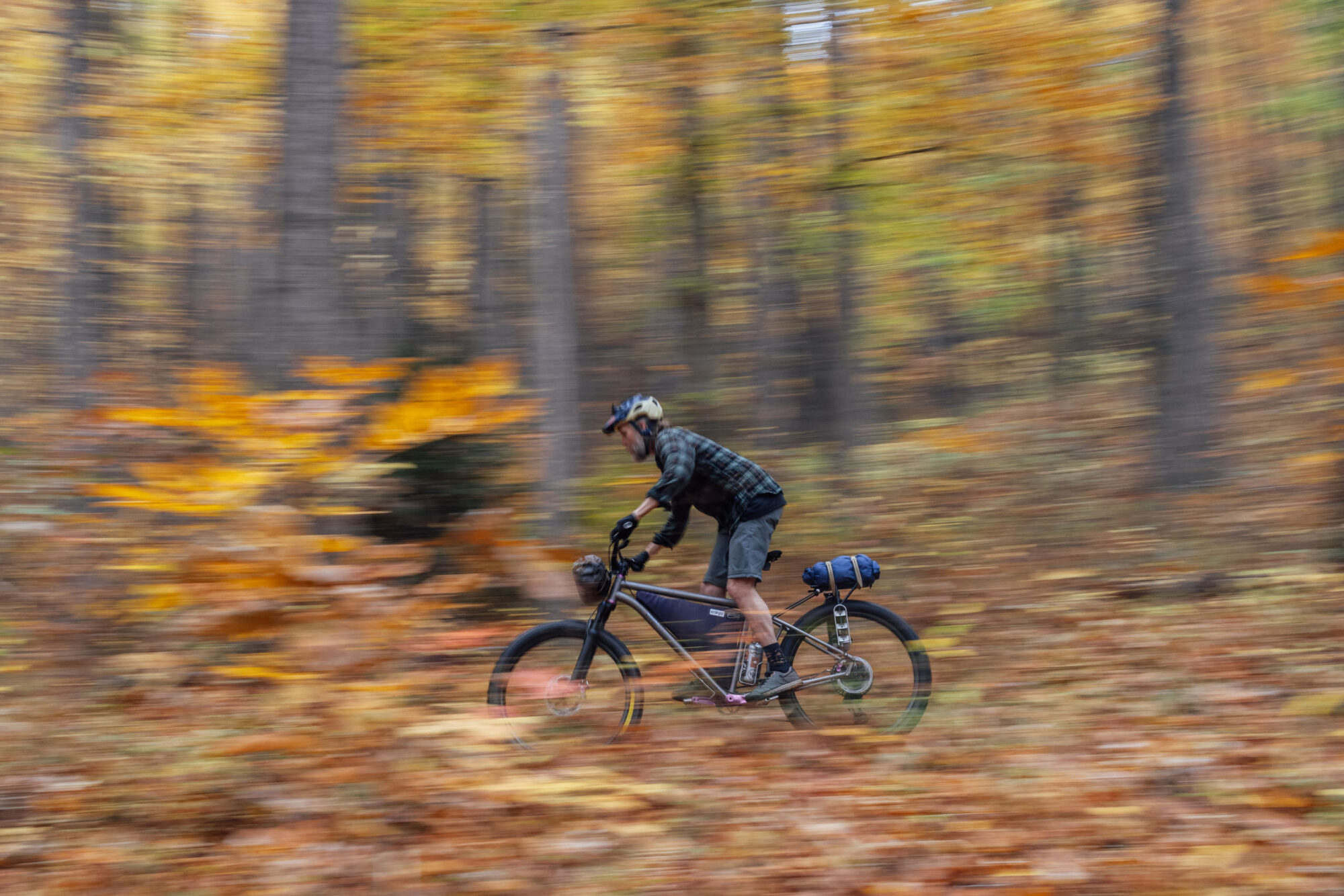
One quality that took me a while to get accustomed to: the timing of bumps is a little different than I was used to, creating a longer than usual pause between the front tire hitting a root or rock and the rear tire coming in contact with it. It’s a strange sensation when you’re used to a standard-length bicycle, which nearly all of us are.
TJ: Growing up, my grandfather had an old Cadillac. I remember riding in the back of that car on the way to the beach, burning things with the old-school push-in cigarette lighter that was in each door, causing my grandfather to pull over thinking the car was acting up. That car rode like a cloud, and we seemed to float down the road without a care in the world. That’s the same feeling I get while riding the Hayduke LVS. The Ti frame and 29 x 2.8” tires recreate that childhood memory for me, minus the burning smell. I affectionately nicknamed it the Cadillac LVS.
Gravel Mode
The Ti frame also does an excellent job at absorbing the chatter and vibrations that come hand in hand with gravel and doubletrack. This—as well as Jay Petervary’s effort on the Great Divide Mountain Bike Route with the LVS last summer—was the impetus for me to rebuild it in gravel mode. I really wanted to see how fast and light I could make this bike and what it would feel like with a rigid carbon fork.
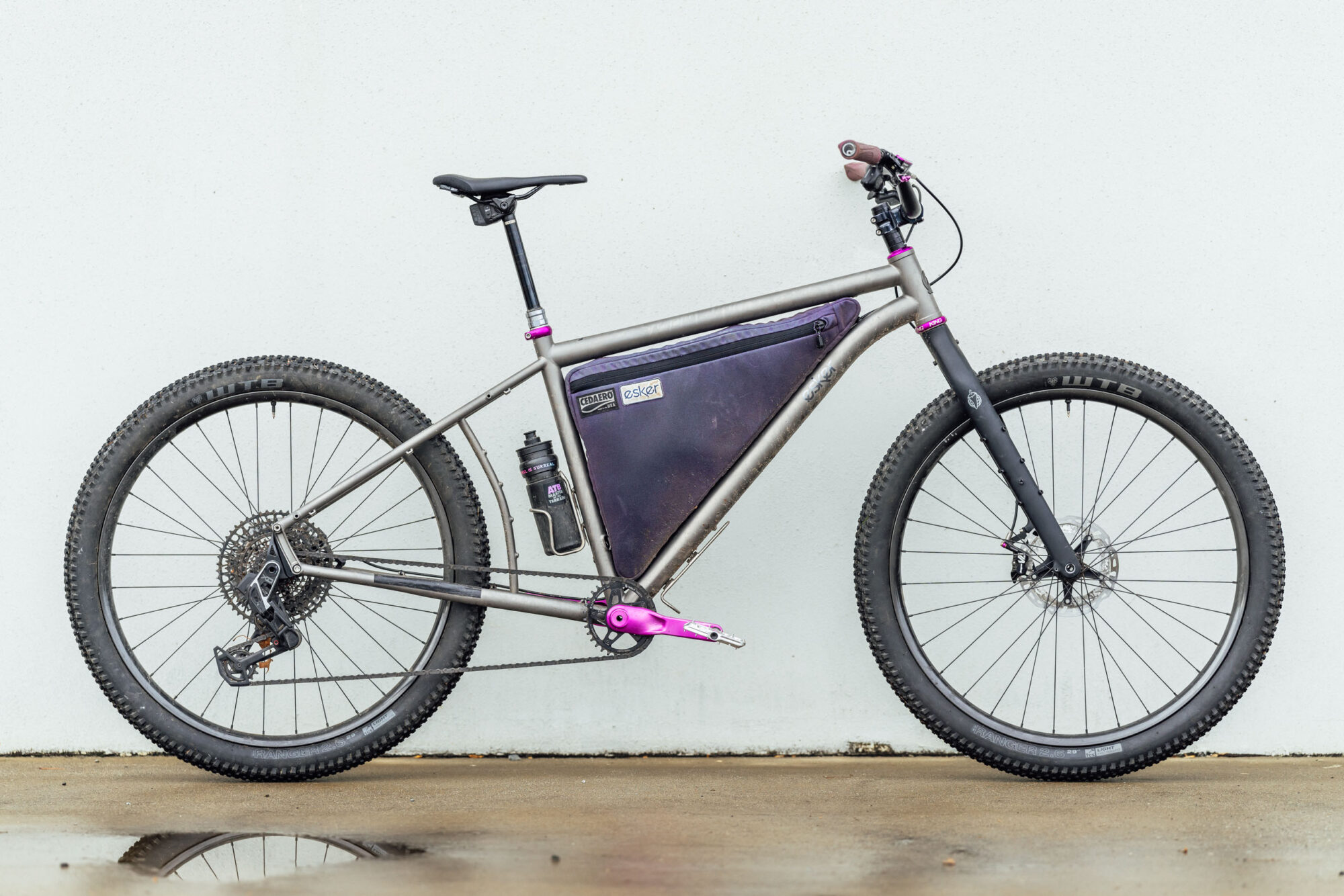
For me, gravel doesn’t always mean 42mm tires and drop bars. Instead, I specced the LVS with 29 x 2.6” WTB Rangers (RIP), a lightweight, fast-rolling, super-versatile tire that I think makes a great ATB and gravel platform. I installed my old Salsa Firestarter Carbon fork, Whisky Milhouse carbon bars, and the Rangers, and the build tipped the scales at 26.16 pounds (11.87 kilograms) without pedals. I was pretty blown away, especially considering the heavy SRAM drivetrain. That’s lighter than all of my bikes, including my titanium Stargazer.
I already felt like the LVS was fast, even with the meatier tires and suspension fork. It accelerated surprisingly quickly, and its grounded stability fostered a kind of mindfulness when pedaling, where you only have to focus on moving forward without any distractions balancing the bike or steering. Kayaks make for a good analogy. Shorter boats enable you to jib and play around but require more work to move ahead, whereas longer ones, like sea kayaks, are built to go fast and forward efficiently and better translate paddle strokes to momentum. These qualities translate even better to gravel and dirt roads than they do singletrack, in my opinion.
TJ: Once we set up the LVS in gravel mode, which consisted of 29 x 2.6” WTB Rangers and a rigid fork, the bike really shined. I felt like the longer stays provided extra stability that allowed me to focus less on balancing the bike and more on pedaling. This isn’t something that I usually notice on a normal-length bike because that’s their nature, but the LVS amplified that a bit by using less of your core on balance and being able to harness your energy for pedaling.
Descending on gravel is an exercise in high-speed control with gobs of traction. The longer stays add a nice forward weight bias, which helps establish extra grip on the front tire and encourages you to push harder and let off the brakes if that is your thing. That added stability and grip comes in handy when you’re flying down the side of a mountain but are tired and deep into a long day in the saddle.
While Out Bikepacking
Like the Hayduke, the LVS has plenty of adventure accessory mounts built into the frame—26 attachment points total. That includes mounts within the triangle for direct bolt-in bags and M6 threaded rack mounts for extra-heavy loads. In addition, the LVS gets that cavernous extra bag space between the rear tire and seat tube. Companies like Rogue Panda, JPaks, Rockgeist, and Cedaero have the frame bag patterns. All-told, the LVS can carry up to 500 pounds (226.8 kilograms) in rider and gear weight; according to Esker, “it was real-world tested at 450 pounds total system weight off-road with no issues.”
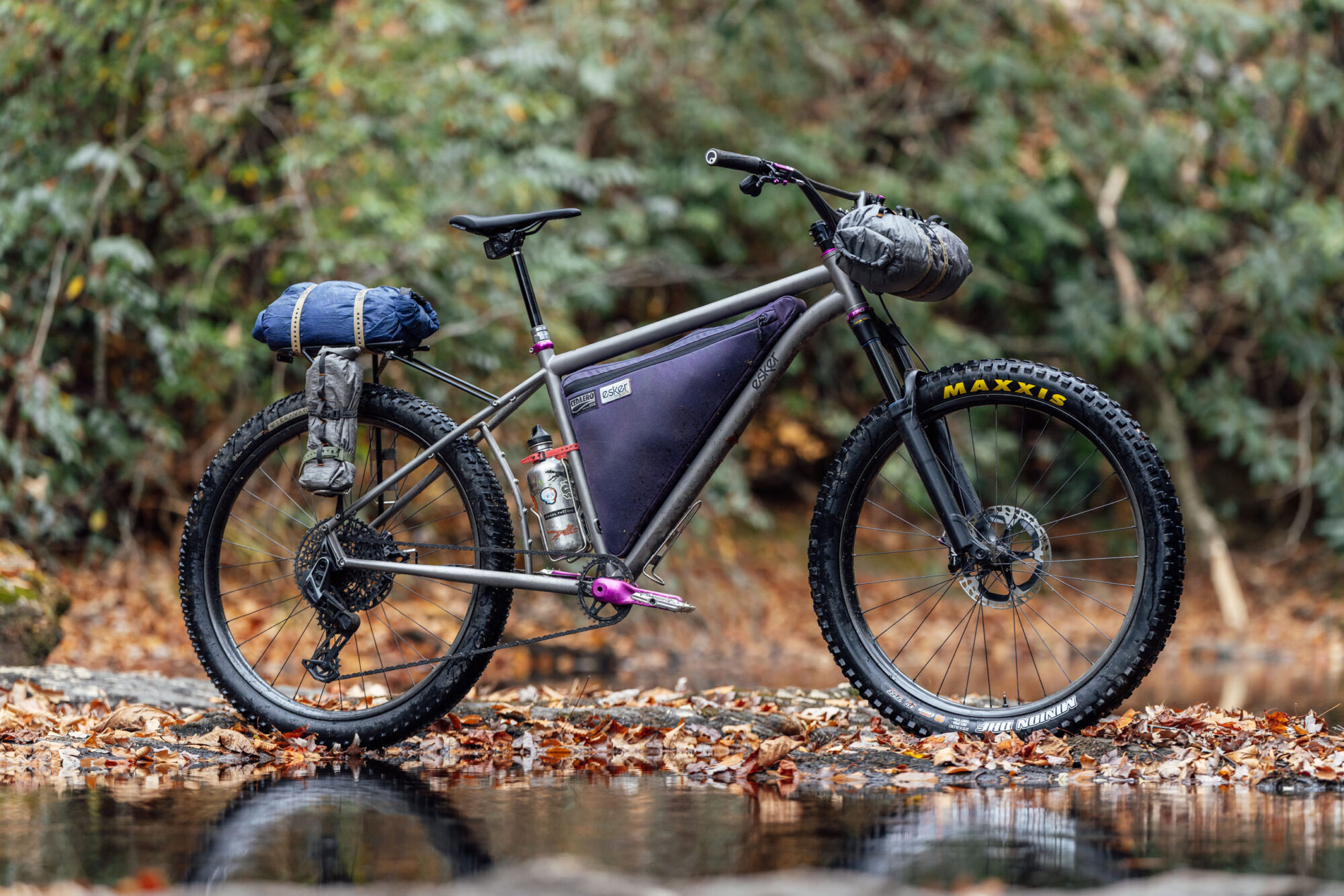
Most people who buy the Hayduke LVS will likely opt for a custom-made bag to fit between the seat tube and the curved vertical stay truss. It’s a pretty voluminous area and another way to centralize load weight, adding more capacity to lower the center of gravity. However, I really liked having a bottle in that space. Typically, I carried a single 700/750ml bottle there for day rides, but I also used an oversized 32oz Klean Kanteen with a larger cage while bikepacking. For the record, that’s about the biggest bottle that will fit in that position; it came pretty close to hitting the chain, particularly when in the low gear.
Still, the ability to load more within the frame triangle(s) shouldn’t be ignored. Theoretically, this should enable most light packers to minimize the weight on the bars and the back of the bike, creating a more efficient platform. If you can ignore the load-carrying capability of the extended rear-end, that is.
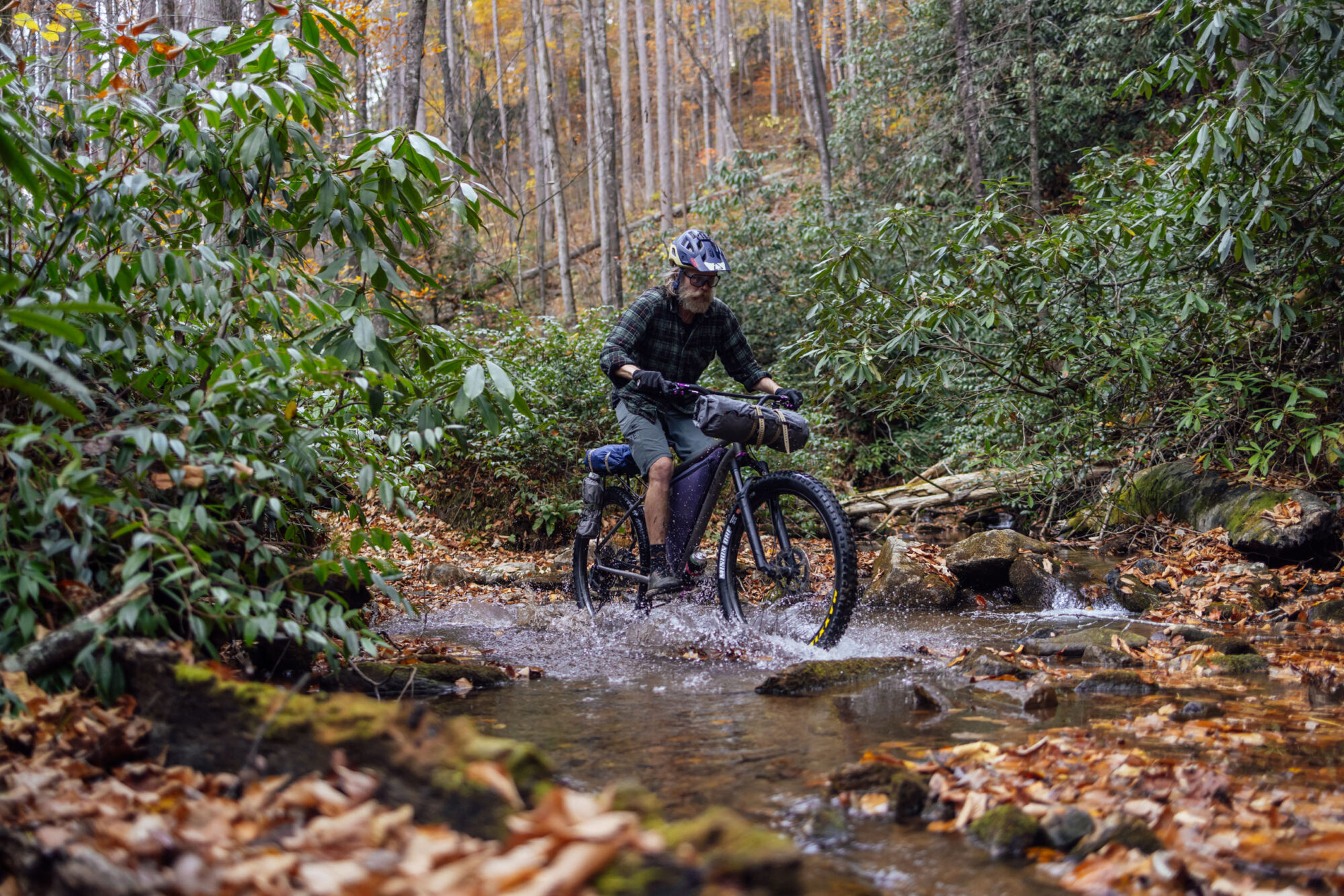
I typically don’t pack a lot and consider myself a comfort-conscious minimalist, so keeping the load light on the front and rear wasn’t that difficult. I did purposefully overpack on one trip, loading the Hayduke LVS down with multiple 16-ounce canned beverages, fishing equipment, and colder-weather gear. The Tumbleweed T Rack provided plenty of provisions to pack a big dry bag on the platform and two cargo cages for other stuff. As you can see in several of these photos, the placement of the rack mounts at the back of the seatstays (or the threaded bolts at the top of the Portage Dropouts) puts standard racks way out in the back. This is something I could feel in the frame a little, especially on twisty singletrack, where the wrangling factor I mentioned earlier was amplified a bit.
TJ: I preferred to load the LVS with a rearward weight bias, giving the bike a more balanced feel than using a handlebar roll. The custom Cedaero bag behind the seat tube was a great place to store my entire hammock setup, including my tarp, which also helped keep the weight lower on the frame. I felt a bit more flex in the frame while it was loaded, but it was nothing compared to my Surly Big Fat Dummy, which gets quite flexy when loaded down. The additional flex adds to the air-ride type feeling the bike already has, and I think Esker has tuned the ride feel of this bike just right.
MOLLE Rackwald (and More on Rear loading)
Esker’s solution to rear loading is a tailor-made rear rack they call “MOLLE Rackwald.” Drawing inspiration from overlanding vehicle accessories, the rack features aluminum MOLLE panels, expanding the range of compatible packs and accessory-carrying possibilities. Additionally, it can accommodate up to four conventional cycling panniers, two on each side. The MOLLE Rackwald is engineered for heavy loads, up to 100 pounds (45.36 kilograms).

I didn’t spend a ton of time with the MOLLE Rackwald, but I gave it a try. Installation of the Rackwald is kind of wild. There are two ⅛” laser-cut 5052 aluminum plates* and five bars made from 8020 extruded aluminum. It kind of has a DIY/Erector Set feeling. The rack’s stiffness is derived from the flexing into place upon installation. When you bolt it onto the rack mounts, it seems like there’s a lot of tension. However, once mounted, it’s not going anywhere.
To put it frankly, the MOLLE Rackwald isn’t really something I’d use. I don’t have a dog at the moment, so dogpacking is out. I also hate winter and cold weather, so there are no extreme sub-freezing trips on my docket, and I pack light so my bikes still feel like bikes and not barges. The Rackwald doesn’t really jive with that. It’s really heavy. The one I tried weighed a whopping 2,648 grams (5.84 pounds). *However, it was a prototype made from 3/16″ plate, and the production version is made from 1/8″ plate, which Esker mentioned reduces the weight of the side plates by about 30%. I’m guessing the final iteration will weigh about two kilograms (4.4 pounds), which is still heavy.

That being said, it’s also pretty handy for folks interested in maximizing the carrying potential of this bike. We tried it in a few configurations to see what it was like to lash various things to the Molle system. For the record, it’s challenging, if not impossible, to attach most panniers as the hooks don’t match the grid design of the plates. The only ones we had on hand that we could make work were the Rockgeist Microwave panniers, which connect using integrated Voile Nano straps. You can fit two of them on each side, but it’s a little cumbersome, especially when you have to reach behind the plates to secure the lower connectors. In my opinion, the most interesting configuration would be a pannier and cargo cage on each side, although I’m not sure how you could attach a cage to the Molle system. I’m sure someone will figure it out, though.
In the end, for us normal gear packers, I think the effect of the rearward load placement I mentioned and the weight of the Rackwald might be justification for a custom rack on the LVS. If money were no object, I could envision a lightweight titanium rack that could fit a set of panniers more toward the fore of the rack—with struts and three-pack cargo cage mounts rearward—adding the option for a cargo bag or bottle and a pannier on each side, plus a dry bag on the top platform. Obviously, folks using the LVS for expeditions involving a lot of gear, dogpacking, or other such exploits may see the value in the MOLLE Rackwald.
- Model/Size Tested: Esker Hayduke LVS, XL
- Actual Weight: 30.88 pounds (14.01 kilograms)
- Place of Manufacture: Taiwan
- Price: $2,950 (frame), $4,950 (complete)
- Manufacturer’s Details: Esker Cycles
Pros
- Beautiful and lightweight titanium frame with plenty gear mounts, ample tire clearance, and versatile dropouts
- Has extra room to carry more stuff yet still generally rides like a hardtail mountain bike
- Supple frame that manages to feel very quick and lively
- Super stable platform that allows you to mindfully pedal and not have to focus on using your core for balance and steering
- Lots of traction for climbing and can slowly tractor up and over anything
- Boosted confidence when descending due to long rear end
Cons
- Sizing isn’t consistent with Hayduke, as originally reported
- Difficult to store in places designed for normal bikes, such as our van, pre-hung wall racks, etc.
- More challenging to pack in bike box and will likely be tricky (if not impossible) to load in a bus or public transport
- Standard rear racks place the load too far rearward, making it ideal for use with a custom rack or the MOLLE Rackwald
Wrap Up
To rewind and put this bike in context, it’s important to see the Esker Hayduke LVS for what it is: a niche bike made to do a little more than typical bikes. In sum, it’s a lengthier-than-normal, longer-range, higher-capacity mountain touring bike. To unfurl the nuance in that statement and wrap things up, I’ll break down who I think this bike is for and how I think it’s best used.
The most obvious target audience is those I mentioned in the last sentence above: riders looking for a gravel or dirt-road expedition bike who need to carry more stuff, such as folks with a dog as a co-pilot. The second most salient use case for the LVS is on a generally long dirt tour. Its ability to centralize weight using the second triangle behind the seat tube shouldn’t be overlooked. Plus, it’s extremely comfortable to pedal and less taxing due to its stability. However, there are drawbacks. Sticking it on a bus or train may be challenging, and fitting it into a tight hotel room might pose some additional challenges. Boxing it for a flight will also add a little complexity. But it’s kind of perfect for a long-distance, non-singletrack-heavy desert route like the Baja Divide. You can load more water, and the long, comfy frame and plus-tire capacity round out an ideal set of specs.
The LVS might also be suited for larger riders looking for a dedicated bikepacking rig for relatively non-technical routes. One thing that makes it special is the fact that it rides like a hardtail mountain bike while still providing the added utility of a midtail. I don’t think that it should be limited to larger folks, but I certainly think bigger and stronger-bodied riders will be better suited to unlocking this bike’s versatility.
Lastly, I think the Hayduke LVS could be perfect for ultra-distance riders looking to lay down big miles on fast rides like the Tour Divide and other non-technical, super-long bikepacking routes. It can be built to be as light as any bike out there, and the long chainstays offer a different way to improve efficiency.
All that being said, I don’t really fit any of these profiles and I want this bike. It’s an impressive frame design that can be built in a variety of ways, each with its own set of strengths. Ultimately, it’s the kind of bike that fuels ideas to unlock interesting trips that could only be possible with it as the key.
TJ: I think this bike would be perfect for any tour where the terrain isn’t overly technical and you need to carry a lot of stuff or just want the added stability of the long wheelbase. I’m sold on the long chainstays, especially for bikepacking, where the pace tends to be slower, and you’re not worried about “playing” around on the bike. I probably wouldn’t take this bike on something like the Colorado Trail or The Real Pisgah unless it was part of another route. I think the long wheelbase with all of the drops and steep rollovers would be more suited to a shorter wheelbase bike/full-suspension where you can manual off things to avoid smashing a chain ring. This bike is more than capable of doing those routes. I just think there are better tools for the job.
Esker Hayduke LVS Review Video
Long or mid-tails are nothing new; they’ve helped bikepackers carry cargo across very remote regions for years. But the problem has always been a lack of options, so when Esker launched the Hayduke LVS this past fall, we knew we needed to jump on one. After a few months of use, Neil shares all the details from how it pedals, where it rides best, and how it just might be bikepacking royalty.
Further Reading
Make sure to dig into these related articles for more info...
Please keep the conversation civil, constructive, and inclusive, or your comment will be removed.






